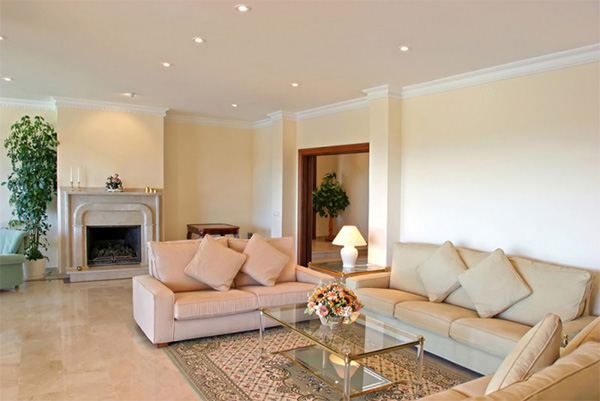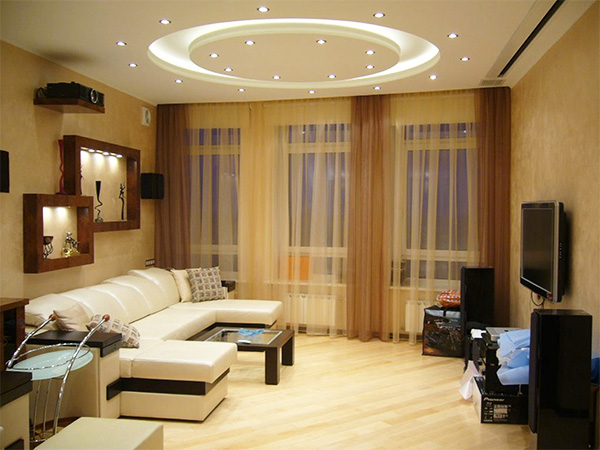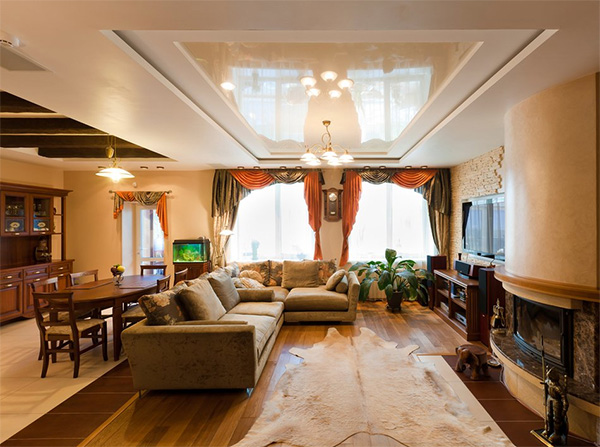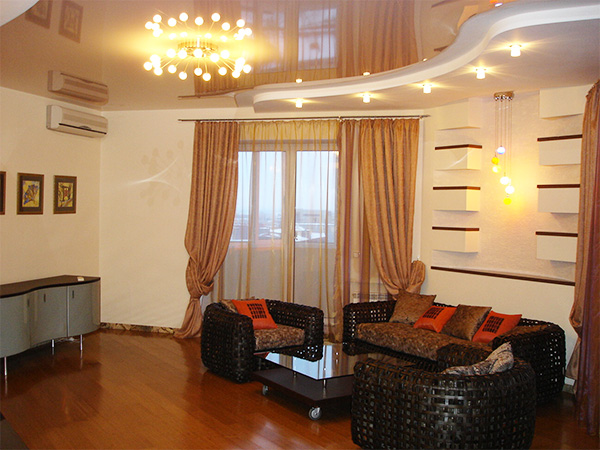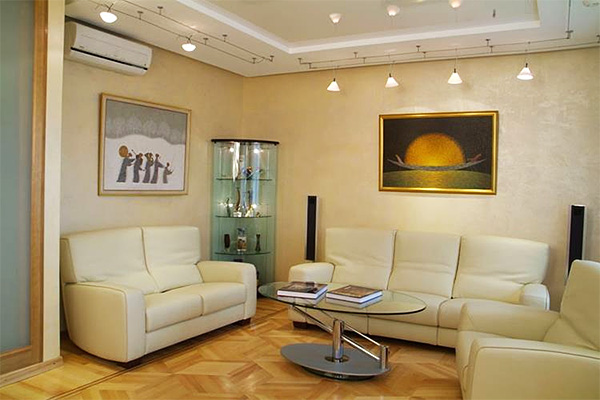Two-level ceiling in the living room with lighting. Single-level stretch ceiling in the living room. Features of the design of plasterboard ceilings: photos of different interiors
To create a positive impression on visitors, the decoration in this room is carried out using expensive materials and sophisticated technologies. The owners themselves will be pleased with the impeccable appearance rest rooms. Significant advantages are able to provide ceilings for the living room from. Photos with examples of completed projects demonstrate decorative diversity. But no less interesting is the study of technological processes. Their correct application will help to realize the most daring plans without excessive costs.
How to create plasterboard ceilings for a living room: photo examples and description of technological processes

This example will help clarify the potential possibilities of structures of this type:
- It can be seen that this solution allows you to create perfectly flat surfaces of a large area.
- In large rooms, several levels are used to create an attractive appearance. The same is useful for designating individual functional areas.
- Installation of built-in, suspended and hidden in the cracks fixtures is acceptable.
- Speakers are mounted in certain places on the ceiling to create a uniform acoustic field. This solution provides the effect of presence in multi-channel audio playback.
- Inside the suspended structure, there is room for boxes, laying electrical power networks, and transmitting information.
Related article:
Now this view lighting fixtures is in every home. In this material, we will understand the structure of light semiconductors and decide how to choose LED bulbs for home.
Advantages and comparison with other methods
- This material is inexpensive. It is not difficult to purchase sheets in a specialized store, taking into account the characteristics of a particular technical task.
- No extensive ceiling preparation required. With the help of drywall, even large irregularities are eliminated.
- In the distribution network, you can buy standard components for forming a frame of any level of complexity.
- Simple assembly operations able to reproduce without error any person. Elementary skills can be learned with detailed instructions(given below).
- Damaged drywall areas can be repaired quickly and cost-effectively.
- This material is made from environmentally friendly components. During operation, it does not pollute the atmosphere of the premises. Gypsum does not support combustion. With special additives - sheets become resistant to high humidity.

A high degree of skill is required for precise alignment using this technology. To create several levels, you still have to set the design of the desired shape.
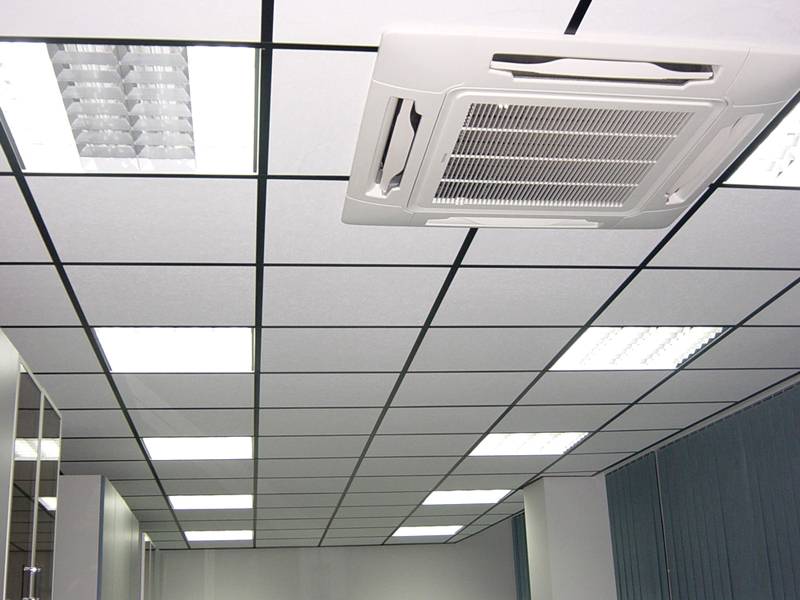
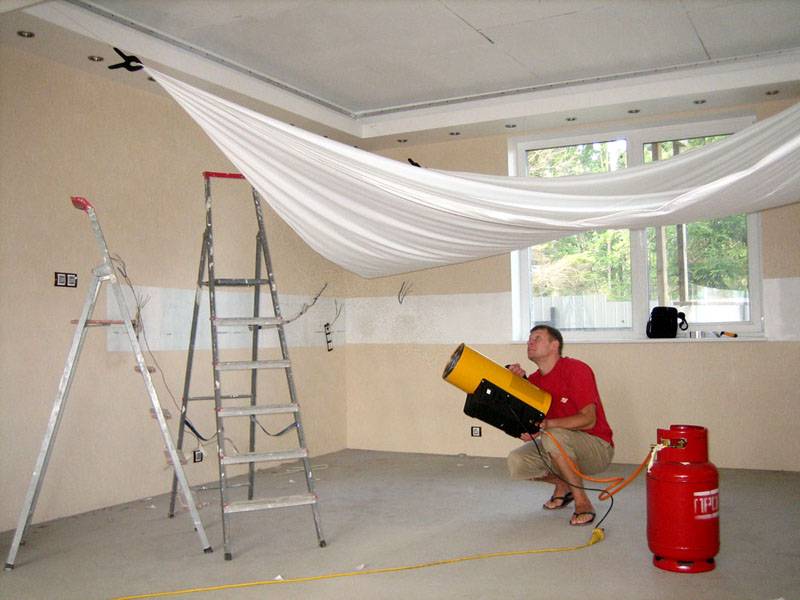
Such structures are not able to provide surface rigidity. The movement of air during ventilation and vibration cause vibrations that are unpleasant for the eyes. The fixing points of the luminaires must be determined precisely, since the appropriate fasteners must be installed in advance.

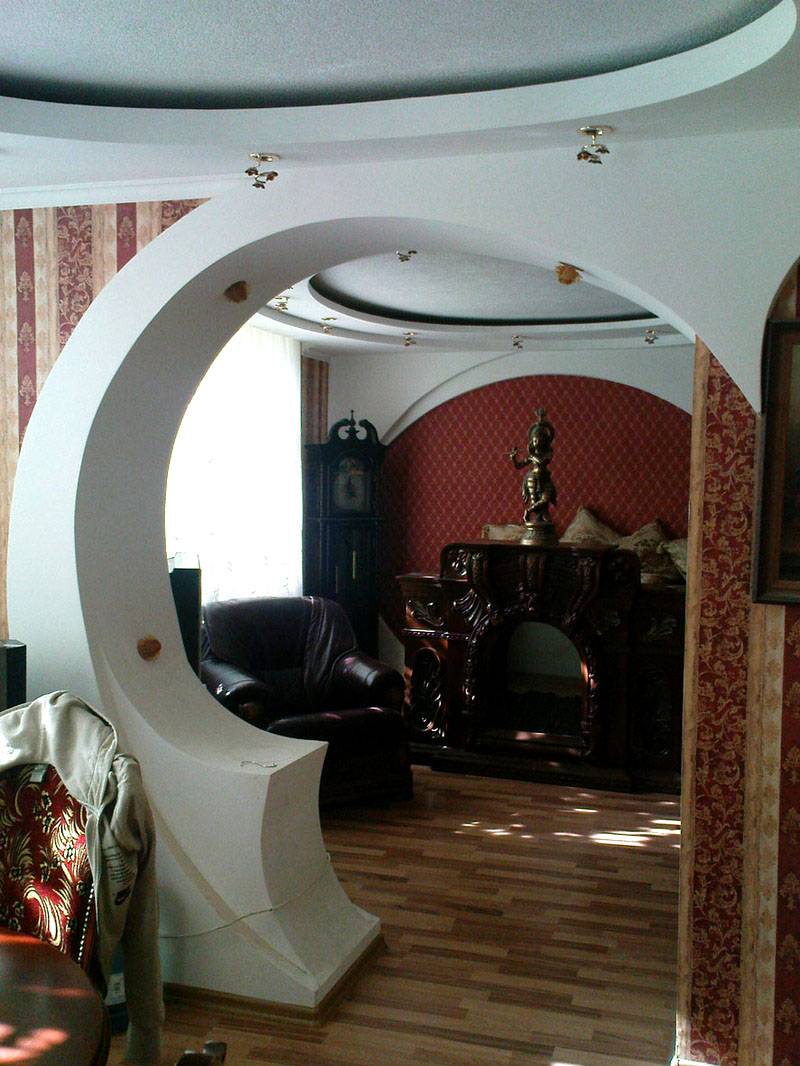
Preparatory stage
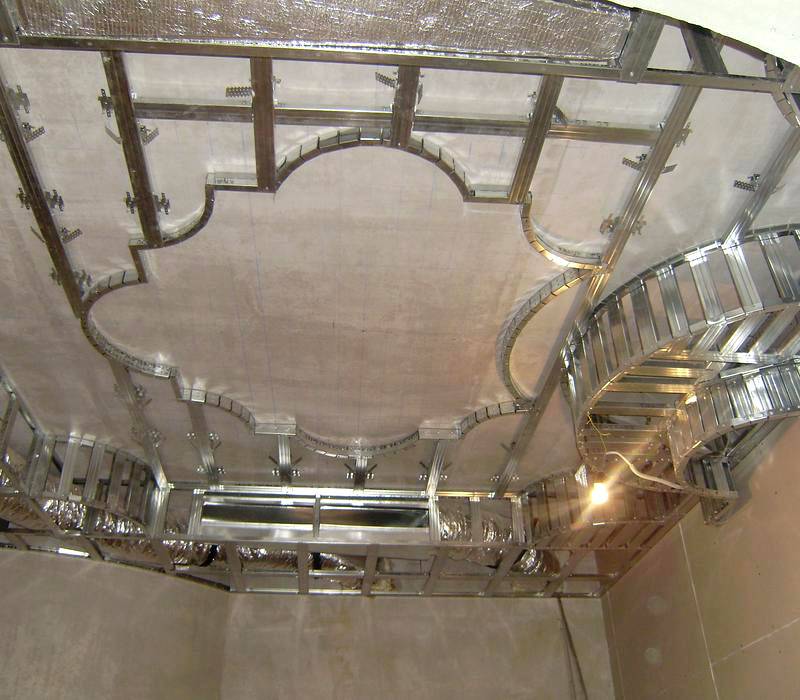
The design of the ceiling can be complex, so preliminary drafting of project documentation is useful. This photo of plasterboard ceilings for the living room shows that it is necessary to take into account the features of the installation of engineering networks.

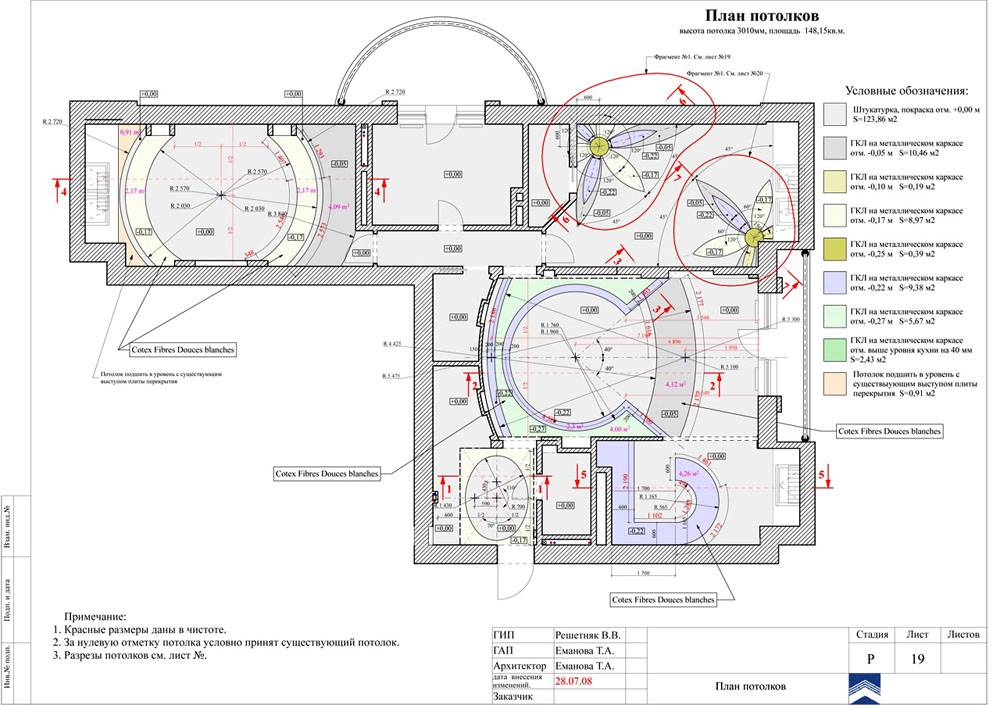

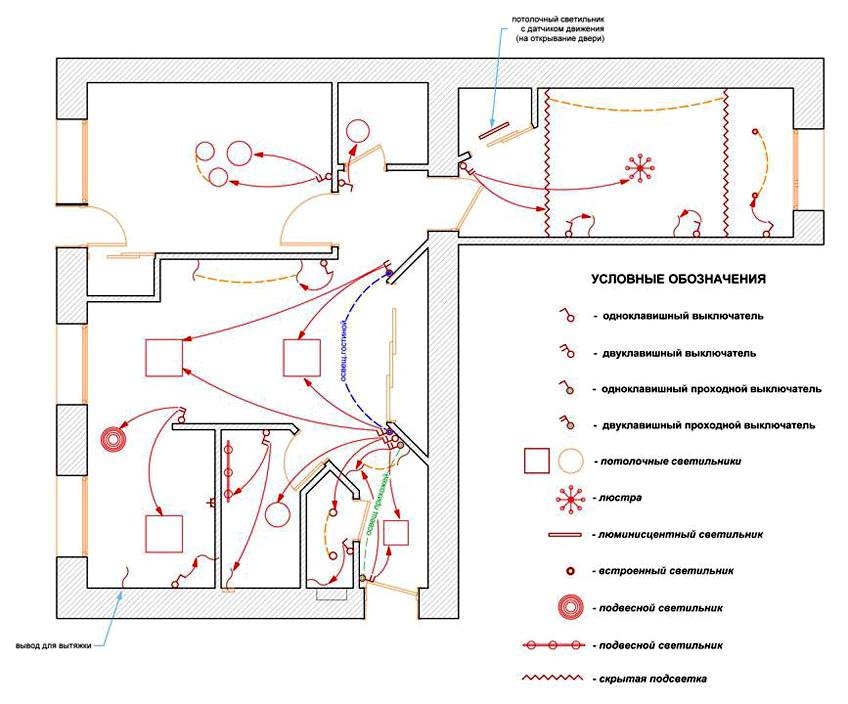
The installation locations of the devices are supplemented with a similar description. With its help, the number of fixtures, the composition and parameters of the switches are specified.
Tools and materials
In most cases, parameters are sufficient standard sheets. If there are relevant concerns, you can purchase moisture-resistant drywall (indicated by the abbreviation "GKLV").
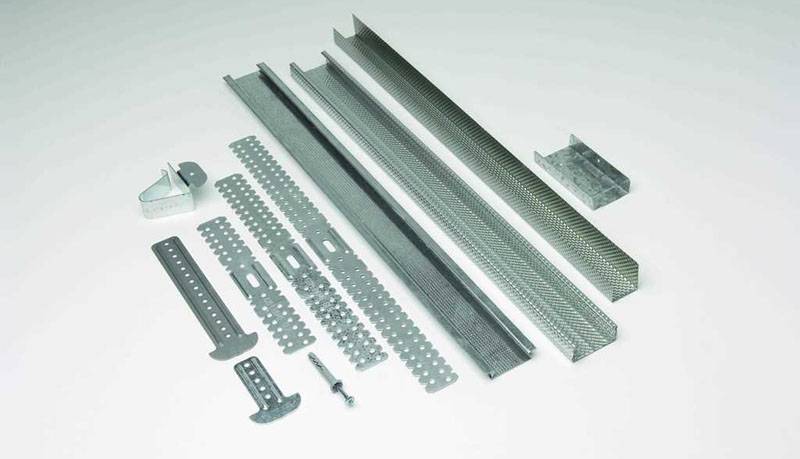

It is necessary to properly prepare in order to create high-quality plasterboard ceilings for the living room. The photo shows only part of the necessary products. An exact shopping list will be formed after a detailed review and selection of a specific technology, taking into account the following remarks:
- To cut sheets in straight lines, it is enough to use a sharp clerical knife. Complicated cuts are made using a jigsaw.
- To drill it is necessary to purchase additional nozzles with jagged edges. They cut holes for the lamps.
- Many screws are difficult to tighten by hand. That is why it is better to buy a specialized tool with an electric drive.
- You will also need personal protective equipment: cotton gloves with rubber pads, a respirator, goggles.
- Align the joints and recesses above the heads of the screws with a putty mortar, reinforcing construction tape, sandpaper. It is necessary to prepare in advance the necessary consumables, containers suitable for diluting solutions.
Algorithm for mounting suspended ceilings for the hall: photo and step-by-step instructions
| Photo | Sequencing |
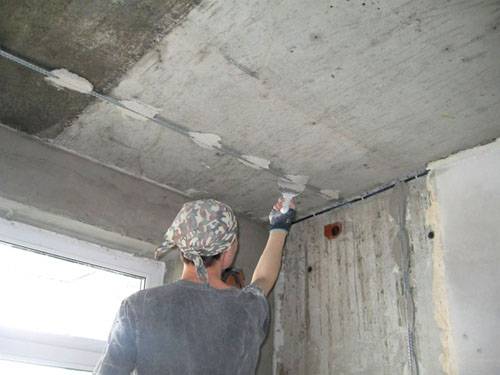 | Remove fragile from the ceiling old paint, plaster. Close up through holes. It is not necessary to level the surface. |
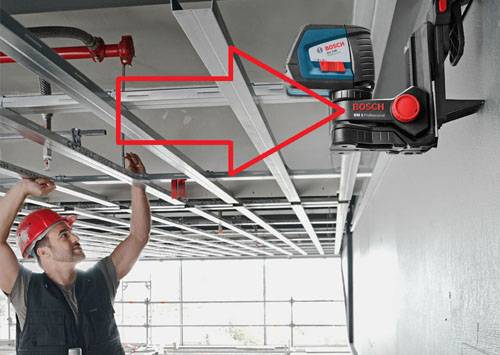 | The figure shows a laser level. Such measuring devices used by professionals. But to solve everyday problems, simple means will suffice. In the room, using a regular tape measure, determine the corner with the highest height. With a measurement from the floor level, mark a point at a distance of 100 mm from the ceiling. Next, use the building level to draw a line along the contour of the room. |
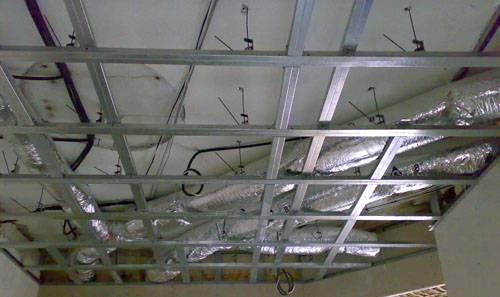 | The amount of free space is adjusted taking into account the placement of sound and thermal insulation, engineering systems. If it is not intended to install built-in luminaires, then the corresponding distance can be reduced to 40-60 mm. |
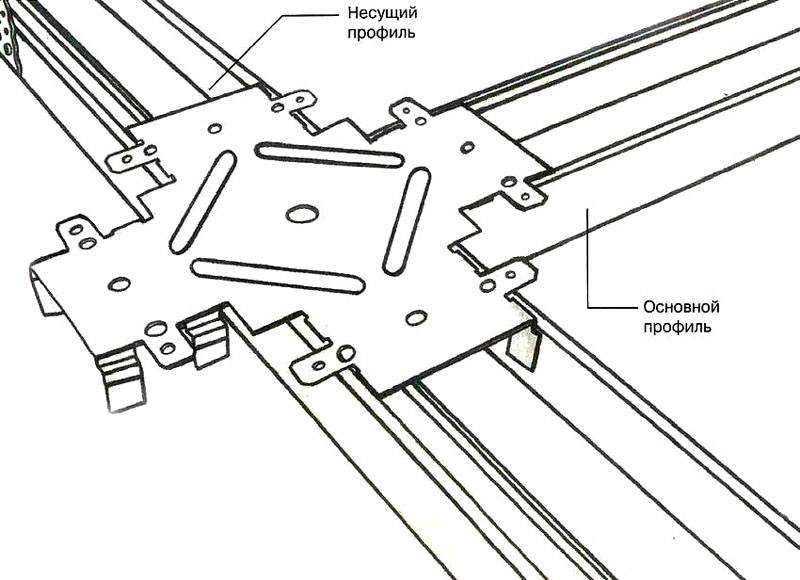 | Suspensions are attached to the ceiling with the help of dowels and anchors in increments of 35-45 cm. Such a lattice of main and supporting profiles is mounted on them. In simple single-level structures, cell sizes are set from 40 to 60 cm in width. The simplest device in the form of a stretched strong thread will help to maintain the accuracy of the level. |
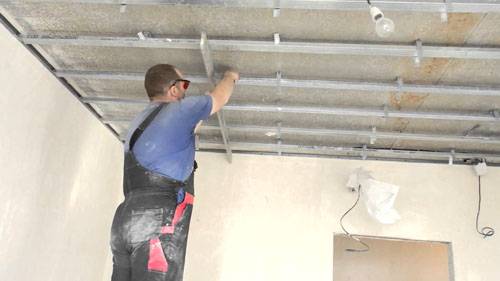 | First, the main profiles are connected to the suspensions, and perpendicular guides are already connected to them. |
 | If multi-layered cable is used, no additional protection is required. Networking is allowed in . At the connection points of the fixtures, a supply of wire about 60-80 cm long is left. |
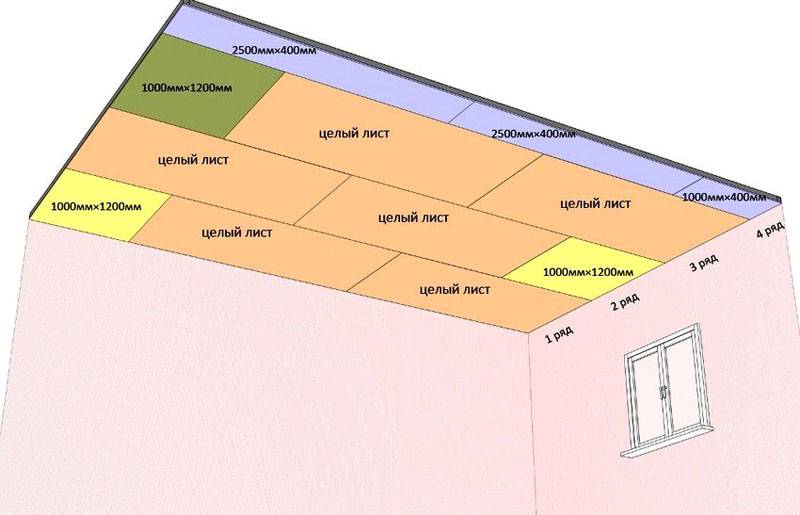 | Such a plan will help determine the cutting parameters. The plate is placed on the table and an incision is made with a knife along the marked line. After a slight break, the sheet is turned over, cut from the back. A planer is used to remove roughness. |
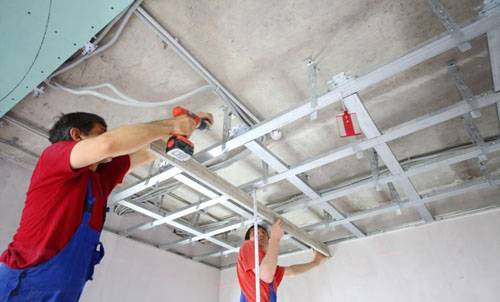 | Mounting operations are more convenient to do with an assistant. |
 | Screws are screwed to a depth of 10 mm or more into a metal profile with a pitch of 90-140 mm to ensure reliable fastening. The sheet will remain intact if the distance of their installation from the edge is at least 10-15 mm. The cap is about 1-2 mm deep into the drywall. |
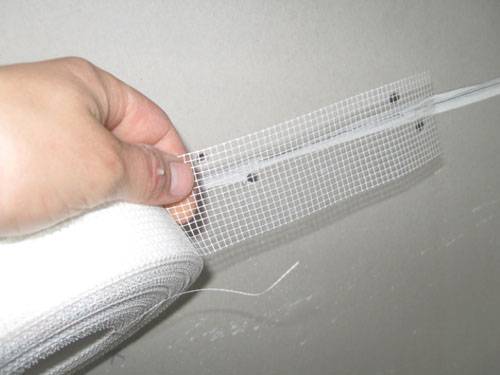 | The joints between the sheets should fall on the profile. After the installation is completed, a pause is made for approximately 48 hours. Next, the gaps are covered with a putty solution, the gaps are pressed, the reinforcing tape is pressed, and it is covered with the same construction mixture. After drying, smooth the surface with sandpaper. |
| Holes for lamps are created using special nozzles. | |
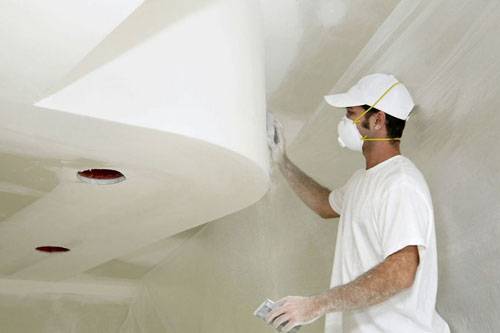 | At the final stage, the smallest defects on the surface are removed. Next, according to the appropriate method, a topcoat is applied. |
Features of the design of plasterboard ceilings: photos of different interiors
This section provides examples of relevant designs. This photo gallery of beautiful plasterboard ceilings will come in handy for clarifying the parameters of the design assignment.
1 of 7
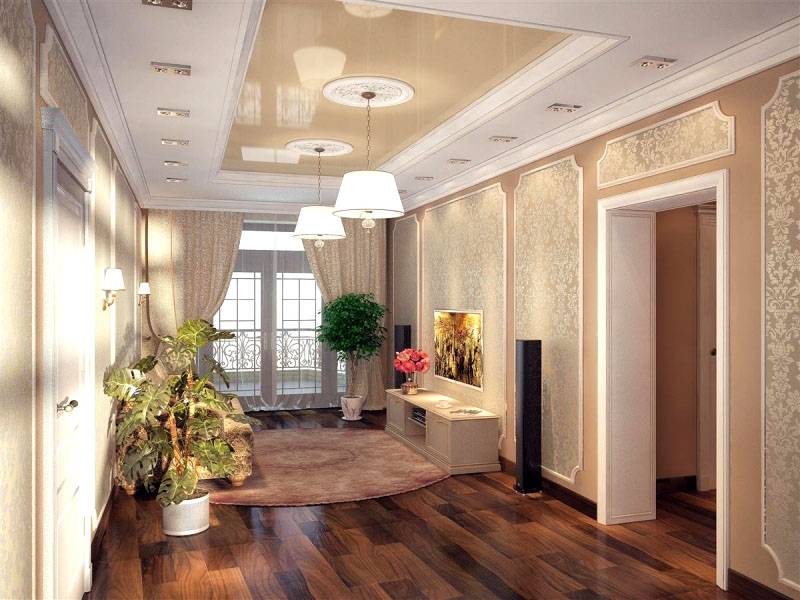

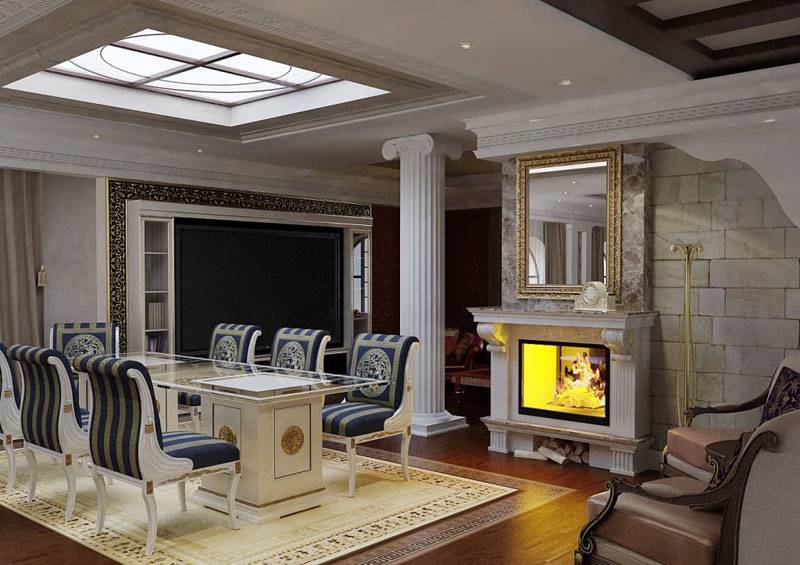
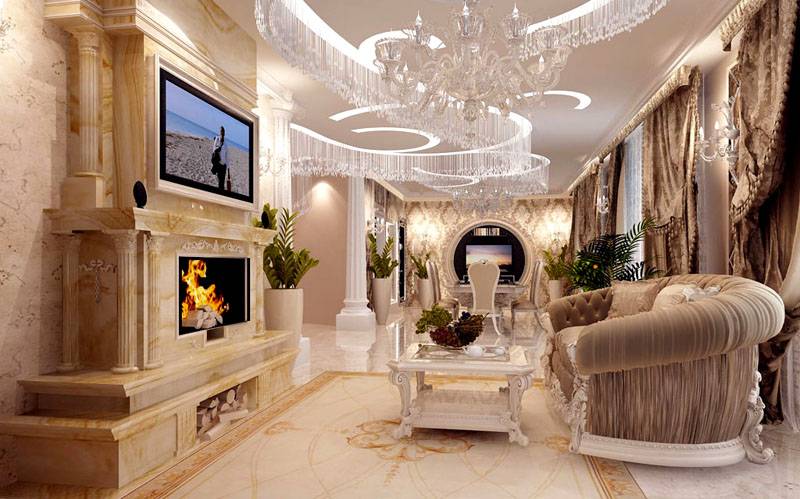
Baroque style Such solutions are used to create a relief on the ceiling. Its presence transforms an overly simple plane into a complex figure, which looks appropriate on a large area. At the same time, this technique helps to hide lamps in specially created recesses. Sometimes it is necessary to use several levels of sheathing to mask pipes, protruding parts of the structure.
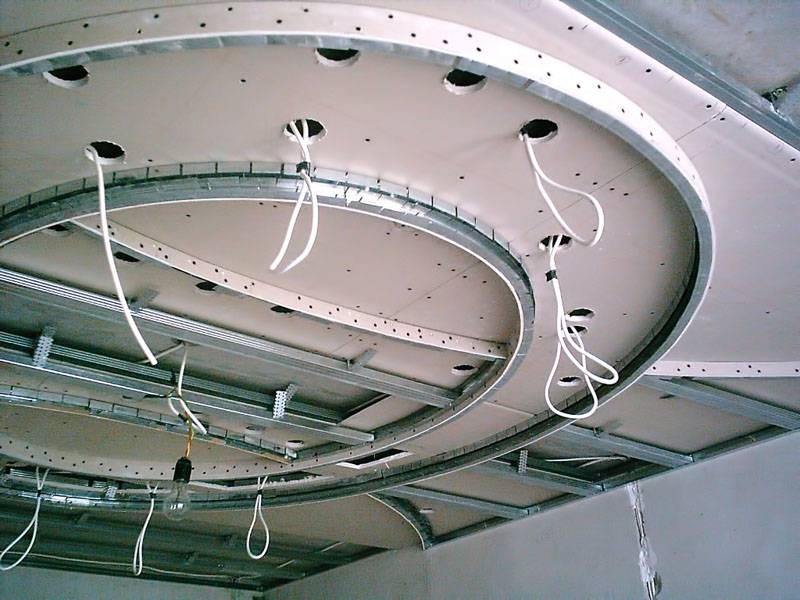
The method of installing fixtures is chosen taking into account their design features
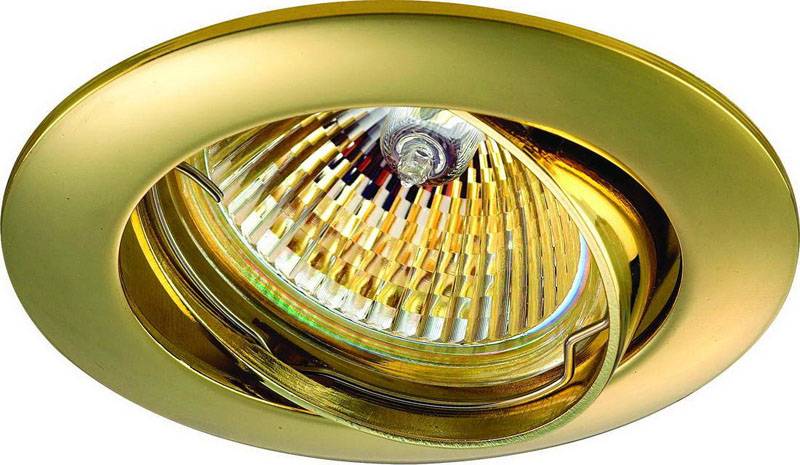
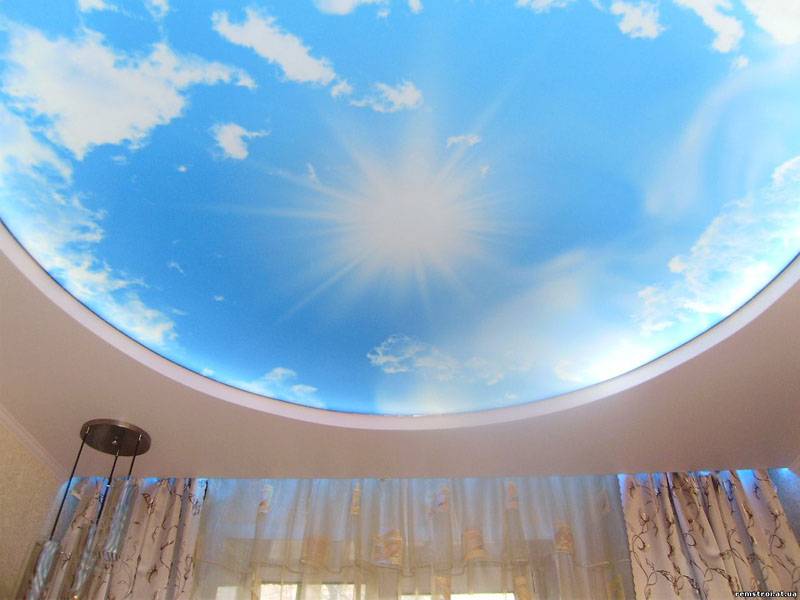
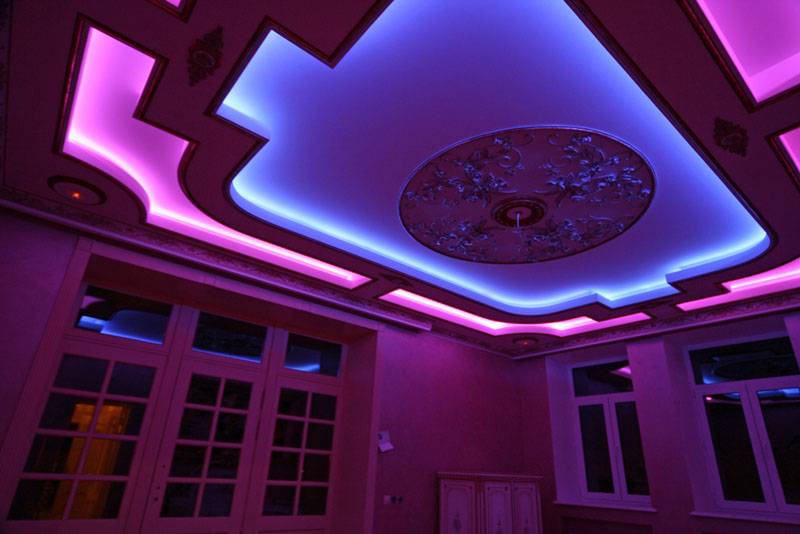
Article
The living room is a room in the house where family members like to spend their free time. Also, festive meetings with guests and friends are held here. The appearance of this room speaks of the general well-being of the family. Therefore, each owner tries to arrange this room in the home as best as possible. Look, plasterboard ceilings: two-level photo for the living room, this will help you choose the most suitable option for your interior.
Not the last place in creating comfort in the room belongs to the design of the ceiling. To emphasize the design, add exclusivity and chic to it, they make two-level plasterboard ceilings for the living room. Photo examples of such ceilings provides the Internet and magazines with relevant topics. A properly designed ceiling will cause delight and white envy in the visitors of the living room.
Sometimes, when examining a two-level or multi-level ceiling, one gets the feeling that for the main task of the owners is to spend a lot of money. But they forget about beauty, they want not only to throw money away, but also to spoil the interior. This is evidenced by photos of such "masterpieces of art."
Not everyone understands that it is more profitable for the installer if ordering a multi-level ceiling is more difficult. Therefore, representatives convince the customer that it is more beautiful to make curves and complex shapes. The result of this is obvious: the installer receives a significant amount of money for the work, and the customer receives a room with a ceiling that is terrible to look at.

But people fully understand what is wrong with such a design of the living room ceiling. The answer is elementary: such a ceiling is the central object of the interior of the room, and this is not typical for the room (including the living room). It is a utilitarian thing, an integral part of the design, and not an independent object in the design of the room.
After all, people don't live with their heads up. And in such an interior, more attention is paid to the inspection and evaluation of the top, because the presence of a huge and colorful structure above the head causes a person to feel danger on a subconscious level.
Why do you need a two-level ceiling
Typically, two-level ceilings in the living room are used for zoning the room. In the presence of a large room and the desire to divide it into functional zones, two-level ceilings that repeat their boundaries will help solve this problem.
If they want to place a dining and sofa area in the living room, the higher part of the ceiling is placed above the first of them. And the sofa area is emphasized by the low part. They also practice building a high ceiling and dividing it using a low level.
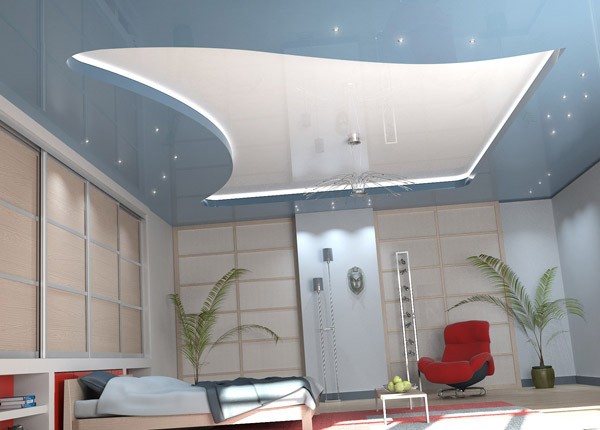
But zoning with a two-level ceiling can only be done in a large room. If your living room regular sizes, use furniture and walls for zoning.
Based on this, we conclude: the first function of a two-level ceiling in the living room is considered to be the zoning of the room (subject to the availability of appropriate sizes).
Two-level ceiling in the kitchen-living room
If the size of the living room allows you to equip a kitchen and a recreation area there, then two-level ceilings are used here as separators of functional areas and places where communication is hidden. In such a plasterboard ceiling, additional lighting and ventilation equipment are hidden.
But the room should be large, and the ceiling configuration should be functional logic. Because, like other ill-conceived objects, the ceiling in this case does not look appropriate or depressing.
When carrying out the design of a two-level ceiling, the upper part is made in the same shade as the dominant color in the interior of the living room. But you need to use this technique to enhance zoning, as in this photo. It doesn't have to look like itself.
In addition, a colored two-level ceiling looks appropriate only in brightened living rooms with a significant amount of white.
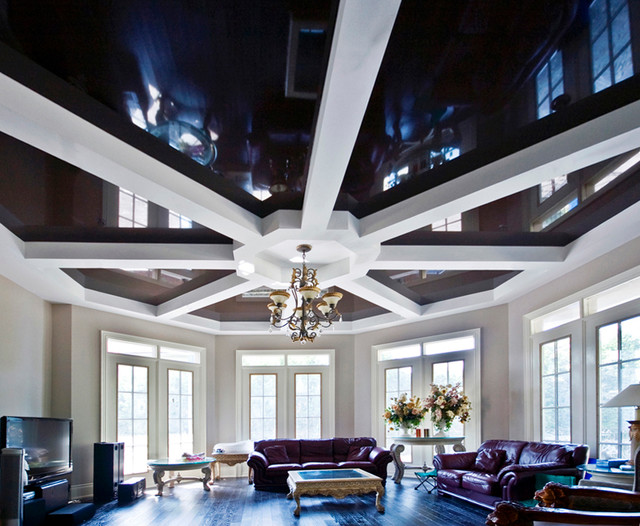
Two-level curved ceilings
Pay special attention to two-level plasterboard ceilings, which have a curved shape. The photo shows that the smooth lines are relevant and no less beautiful. They are often found in modern interiors, so they are no longer considered an innovation.
But if these lines are placed on the plasterboard ceiling in the living room, and even complemented by lighting, the impression of fluidity and dynamism of the space is created. Only those for whom such an effect is desired can decide on them. And the "floating" ceiling additionally needs space as such.
Therefore, a good appearance and overall impression of smooth outlines two-level ceilings are created only when the dynamism of the living room interior is supported by the dynamics of color or layout. If you don't want to have a permanent feeling of floating in the interior of the living room, as in this photo - give up these undulating curves. Not always fashionable means beautiful. Sometimes a simple solution is better for an interior than a novelty.
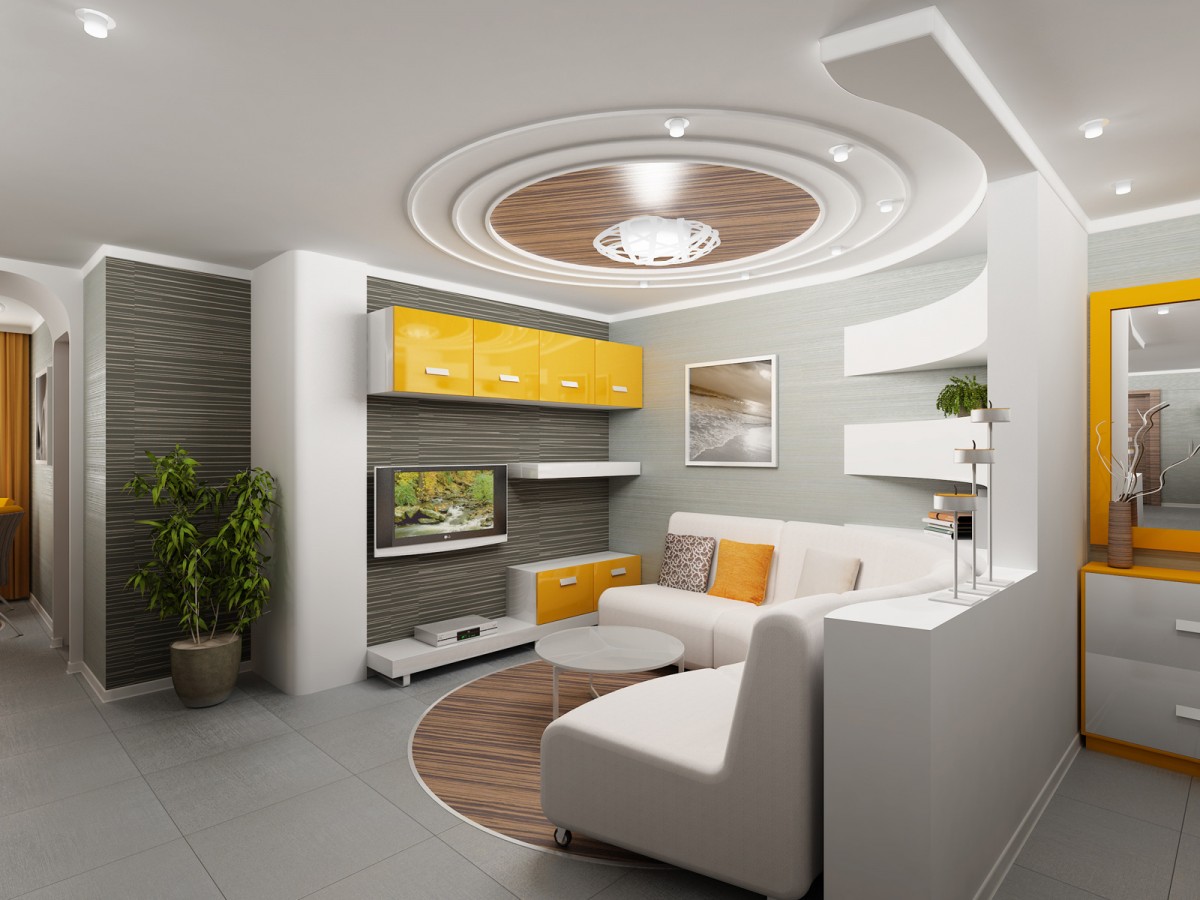
Two-level stretch ceiling in the living room
When two-level stretch ceilings appeared, the time when such structures were created exclusively from drywall ended. In addition, earlier, for the construction of the ceiling, it took a lot of time for puttying, priming and painting. And this is not suitable for everyone.
Another main advantage of a two-level stretch ceiling is a more stylish and modern, fashionable and spectacular appearance. Such a ceiling in your living room will not just be a decoration of the room - with its help, the geometry of the room changes, a mood is created in it.
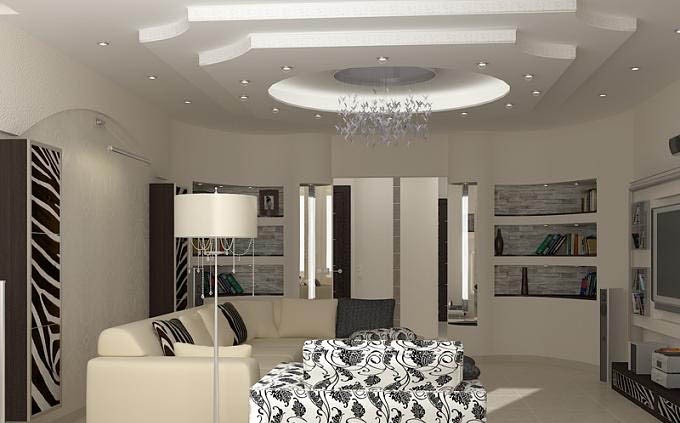
What is the difference between tension and drywall
Two-level stretch ceilings in the living room are two individually mounted canvases, which are placed at different levels and are a complete composition. But, in comparison with the plasterboard construction, stretch ceilings have a number of differences.
Significantly greater variety of tones and textures of film and fabric material.
The original appearance and aesthetics of the ceiling.
Protection of the room from flooding. When inattentive neighbors from above create flooding, a stretch ceiling will save the living room and you from big problems. The material that is used to create such ceilings holds liquid and does not let it through.

Possibility to perform partial dismantling of canvases. This can be useful when it becomes necessary to replace the wiring behind the ceiling surface.
Fast installation. It does not take much time to complete it - in just one day you can complete all the work. Even install lamps and chandeliers.
Advantages of this type of ceiling
- Quick mount. After installing a two-level stretch ceiling in your living room, there will be no need for puttying, grouting and painting. Therefore, installation takes much less time than installing a plasterboard ceiling. It is only necessary to find an experienced specialist who will be able to perform these works qualitatively and in a short time. But not every master can do this, since the correct installation requires a certain amount of knowledge in geometry, and not just the ability to correctly mount the profile and stretch the ceiling. In addition, the more complex the configuration, the more painstaking the installation work.
- Installation cleanliness. As mentioned above, when installing such a ceiling, painting work will not be performed. This means you won't have to deal with dust and pollution after installation. But before carrying out installation work, the entire furniture set and the floor surface will still be covered with a film.
- Variety of rainbow combinations. When choosing stretch ceilings to create a two-level structure, you can safely come up with combinations of dark and clear shades. The photo shows an example of such a solution. In this case, you do not need to worry about the perfection of the joint line.
When painting two-level plasterboard ceilings, a big problem is the transition between contrasting shades - it is almost impossible to make it perfectly even and clear. In this regard, such constructions most often have an ordinary one (in most cases - white) tone. After the appearance of two-level stretch ceilings, it became possible to perform different levels in various colors, while making the outline of their joint will not be a problem, as it will be perfectly even.
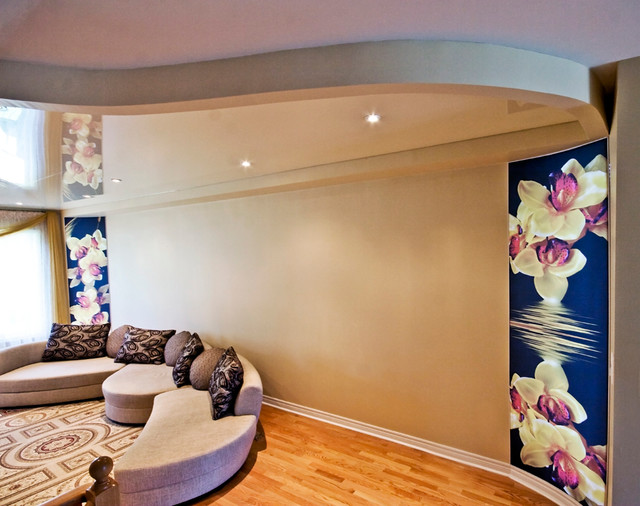
Possibility to perform partial dismantling of canvases. This is useful in the event that it becomes necessary to replace the wiring located behind the ceiling surface.
New space zoning
You can divide the functional areas in your living room not only with the help of levels, but also with the textures and tones of the ceiling. Thanks to this, there are many possibilities, especially in our time, when open layouts, studio rooms, sliding partitions and dynamic modifications of space are preferred, depending on what time of day it is outside or the mood of a person.
Film backlight
When installing a two-level stretch ceiling in your living room, you can make ceiling lighting. And it won't just be hidden led strip located around the perimeter of the box. She represents the level of the ceiling, which shines daylight. The photo shows that to create such an effect, LED strips are placed behind a translucent film.

Number of configurations and 3D designs
Approach the choice of the type of two-level ceiling in the living room seriously. If you have any doubts, entrust a specially trained person to do this difficult task. He will pick it up taking into account the wishes and financial possibilities. In addition, it is much more reliable than doing unfamiliar work yourself. And let the cozy living room with a two-level ceiling become your pride and favorite place in the house!
Plasterboard ceilings: 40 photos for a two-level living room
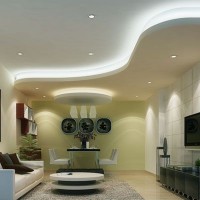
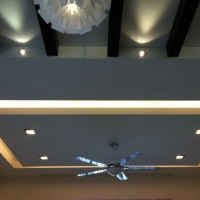
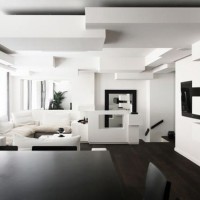
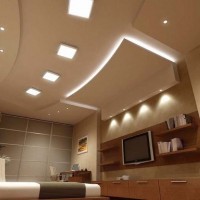


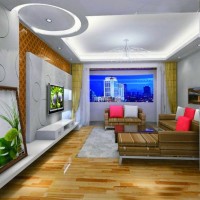
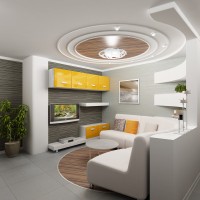

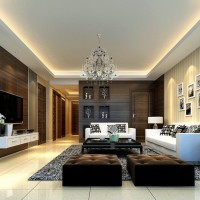


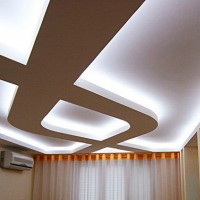
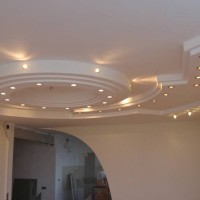
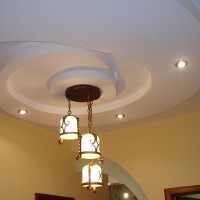
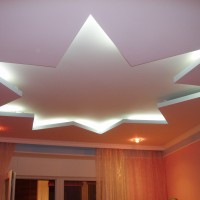
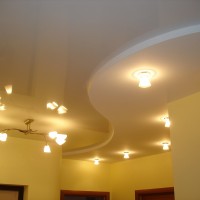

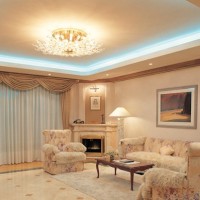
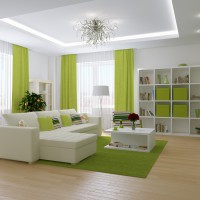

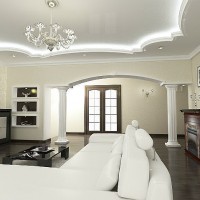
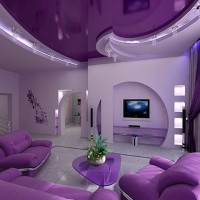
If we compare a few decades ago and today, then special attention has been paid to flows.
At present, every single detail is treated with special trepidation, while it is important that all of them correspond to the general idea and style decision.
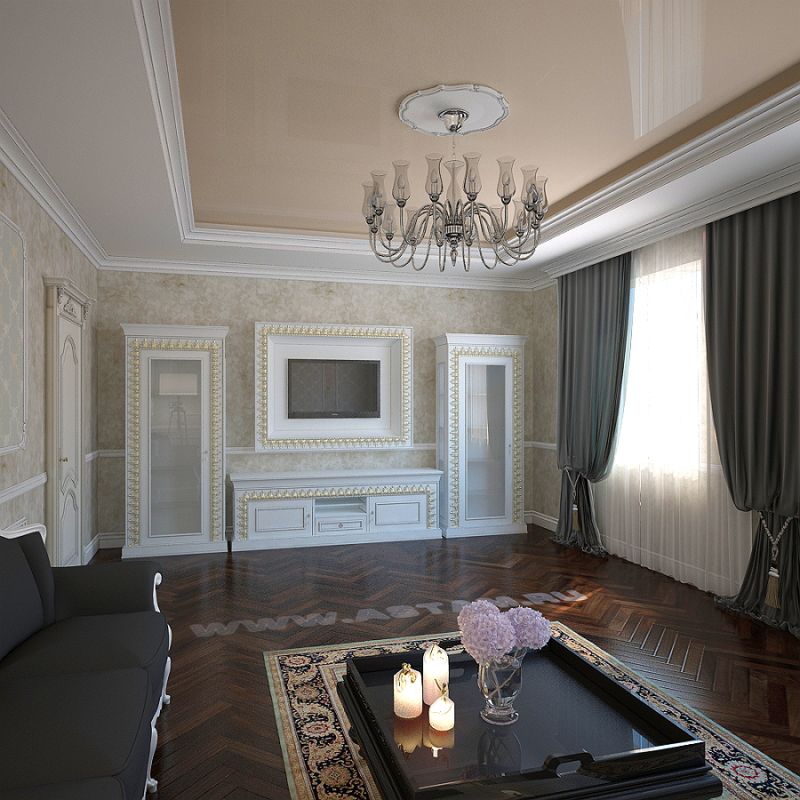
Varieties of ceilings
By their own technical features all ceilings are divided into special categories:
- plastering;
- tension;
- suspended;
- hemmed.
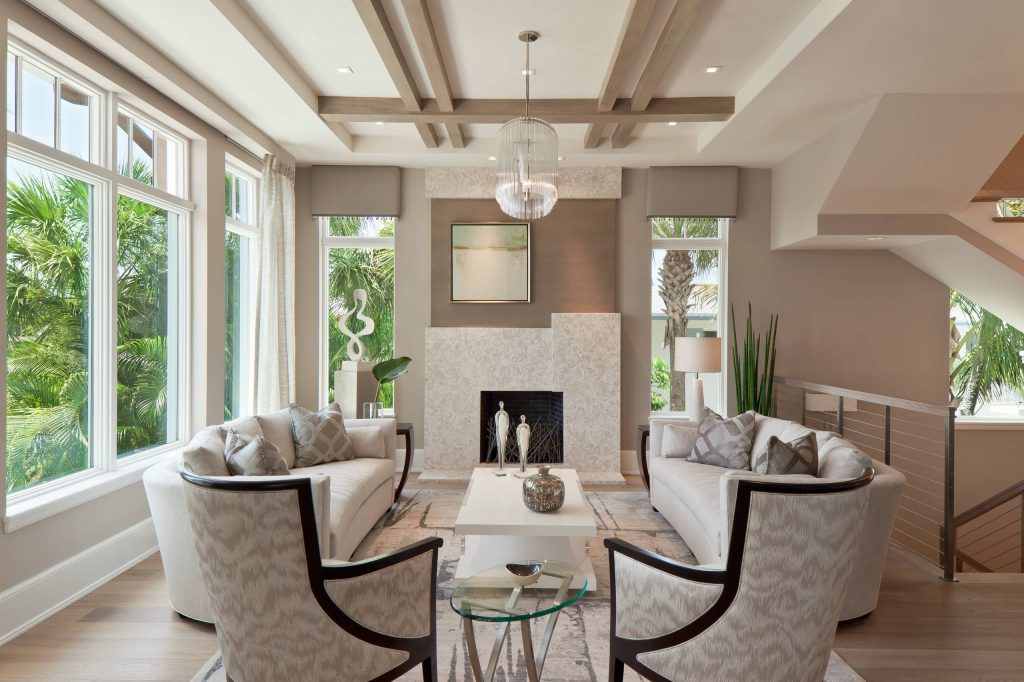
Before deciding on the final version of the ceiling design in the living room, you should consider each of them in more detail, highlighting not only the positive and negative qualities, but also the method of their creation.

What is each of these options?
Plaster. A relatively popular variety, the manufacture of which is carried out using special plaster solutions and further use putties and paints.
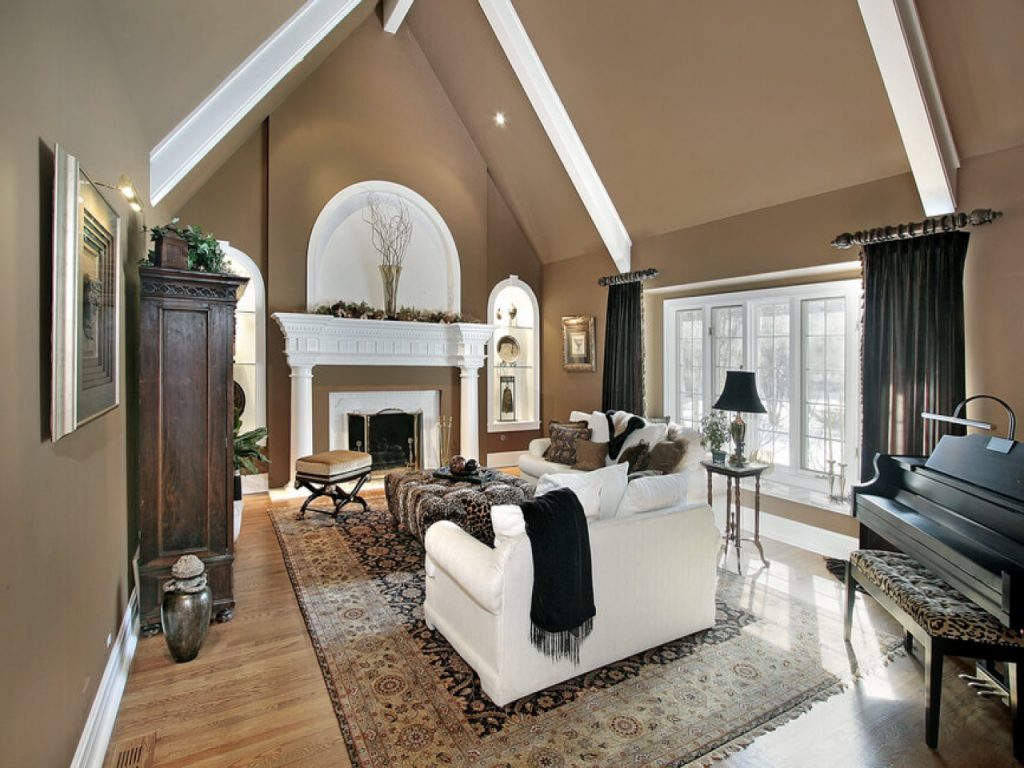
You can also apply wallpaper and some decorative elements. The main advantages include simplicity due to the lack of special materials and tools, strength, long-term operation. The greatest popularity of this type is achieved by the absence of a decrease in the height of the room. The process of creation requires quality.
Stretch. So-called plastic or aluminum profiles are used, which are attached to the base of the ceiling space. After that, experts stretch the canvas from vinyl or fabric. Depending on the texture, stretch ceilings in the living room are distinguished:
- matte;
- glossy;
- satin;
- photo printing.

Such solutions have specific features in the form of a variety of colors and textures, but the time frame for creation is on average exactly the same.
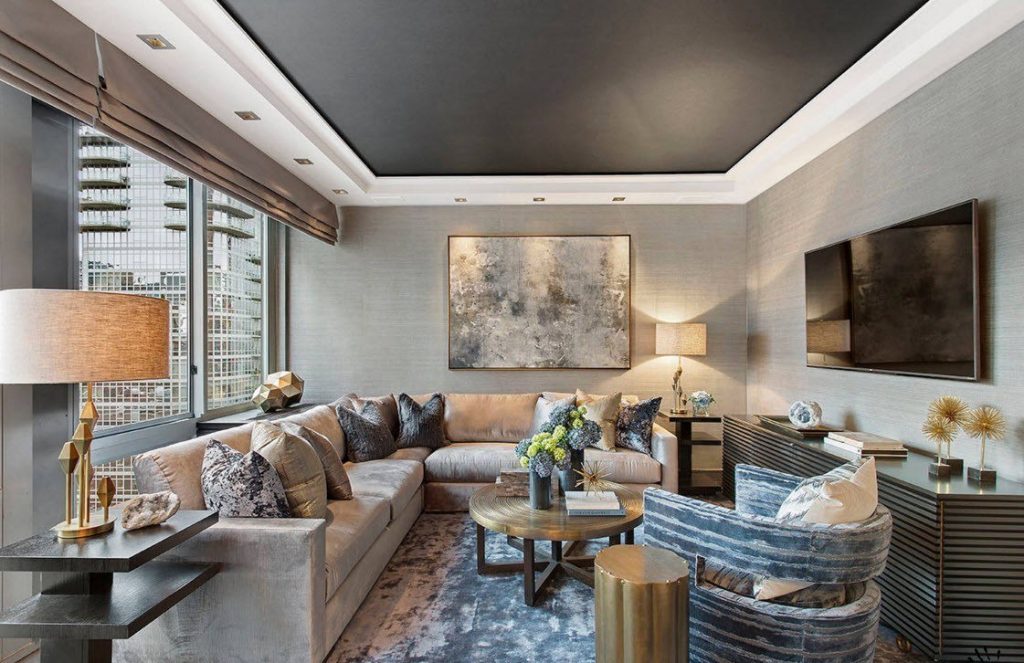
The main advantages of the design of stretch ceilings in the living room include ease of maintenance, strength, reliability and durability of functionality. In addition to the positive qualities, it is also necessary to highlight the negative ones, namely the sensitivity to possible temperature changes.
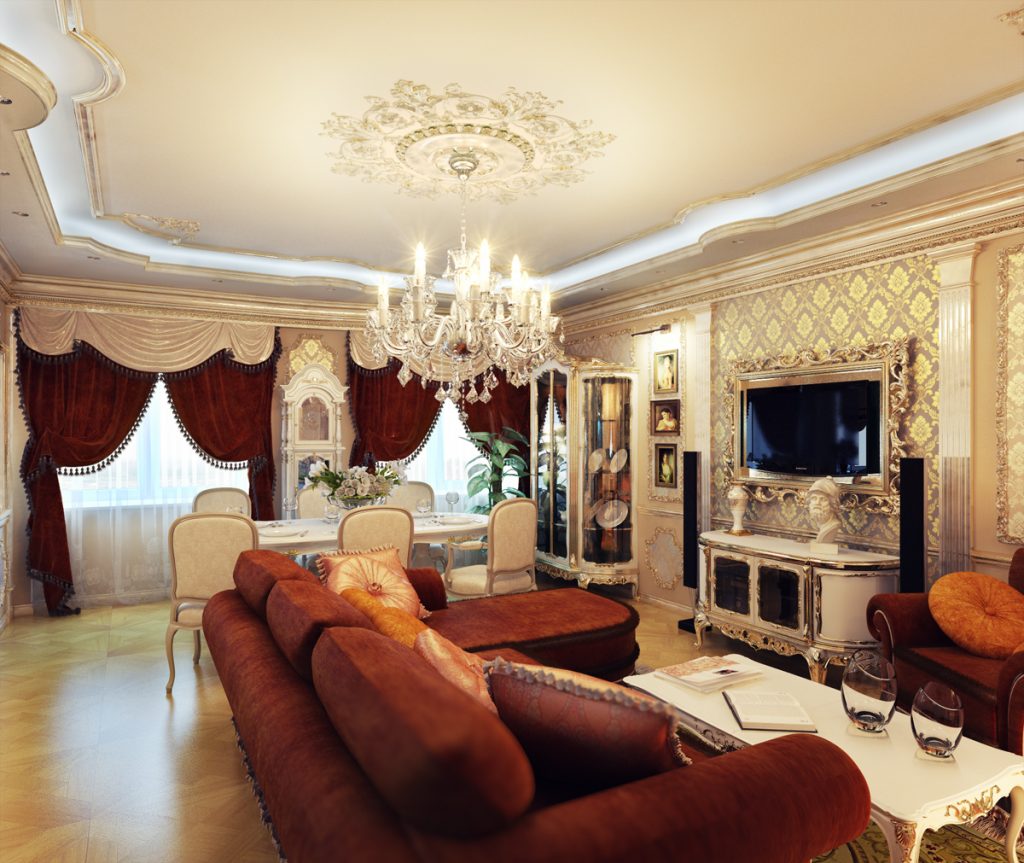
Suspended. Relatively common option. They differ not only in simplicity and ease of installation, but also in low cost. This type has the ability to hide all existing flaws, including irregularities. Depending on the variety of the main coating, the use of the same type of modular panels and a solid version are distinguished.
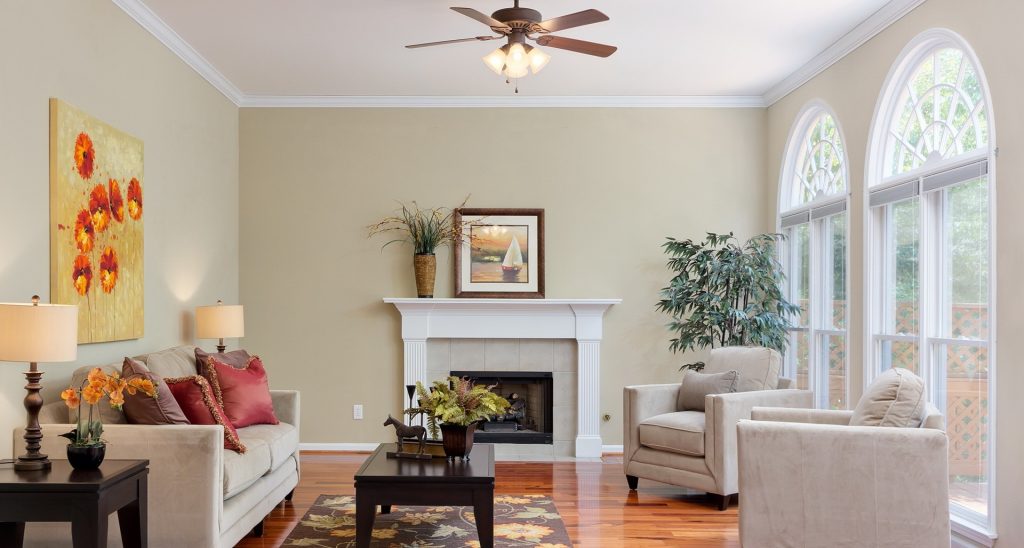
Very often performed in the form of several levels, which can be seen in the photo of the ceiling in the living room. Of the shortcomings, it is necessary to highlight the mandatory underestimation of the height level.

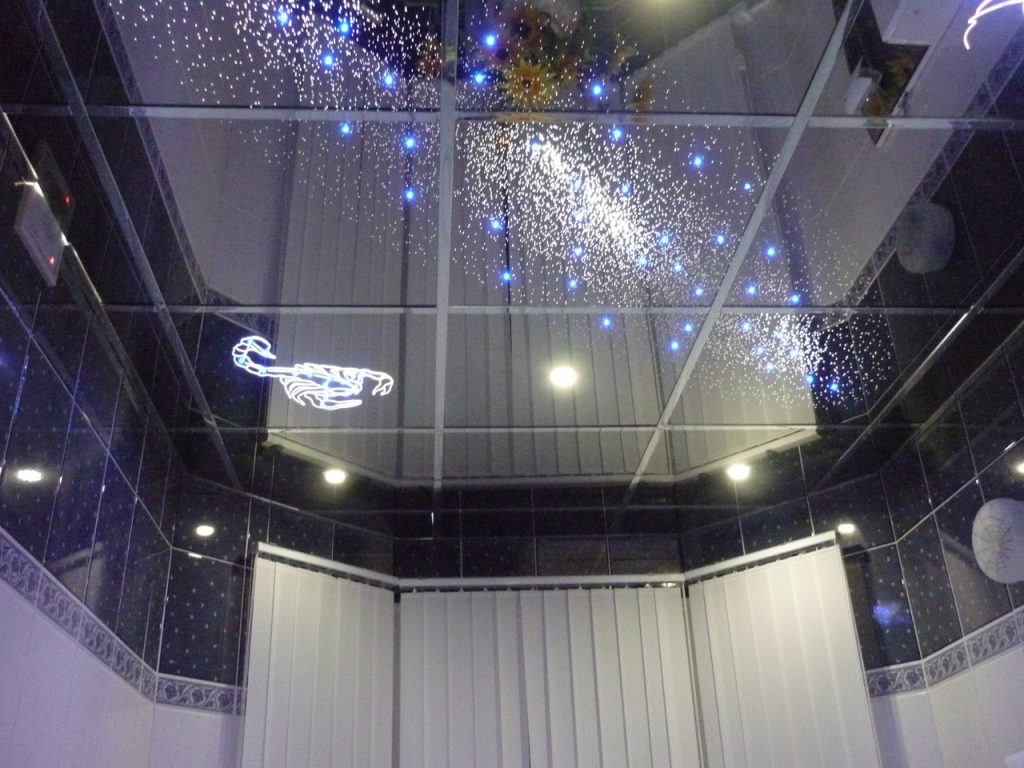
Hemmed. Ready option practically does not differ from the previous one, but the design features include both advantages and disadvantages. In this case, the total height of the ceilings does not decrease, although there is no possibility of mounting lighting and accommodating all available communications.

Duplex. It is quite functional and useful option. The advantage of two-level ceilings in the living room is given to drywall because of the relatively low cost and ease of creation.

Multilevel. Much more interesting than the previous type, but also much more difficult. It helps to give the room a certain volume and division into the necessary zones.
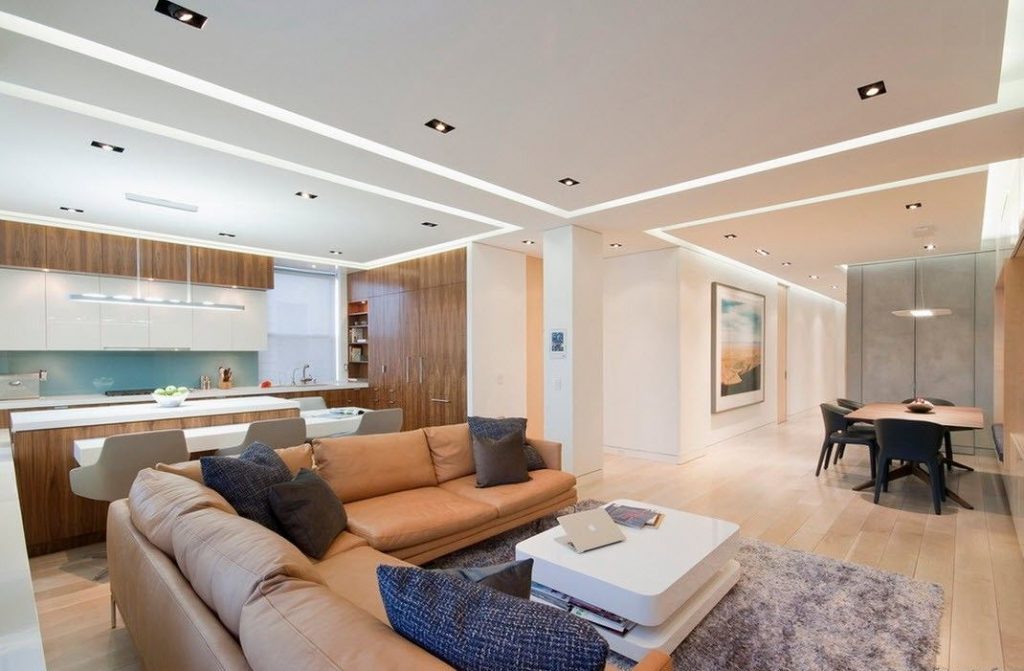
Finishing materials
The main materials that help to carry out the necessary finishing work include:
- plaster is a relatively old material that requires additional repair work;
- drywall - is one of the main elements in creating the ceiling in the living room, namely its decoration;
- MDF - have a variety of colors, do not change upon contact with liquid and as a result of physical impact;
- film and fabric - help to give the most diverse shape to stretch ceilings due to unique property elasticity.
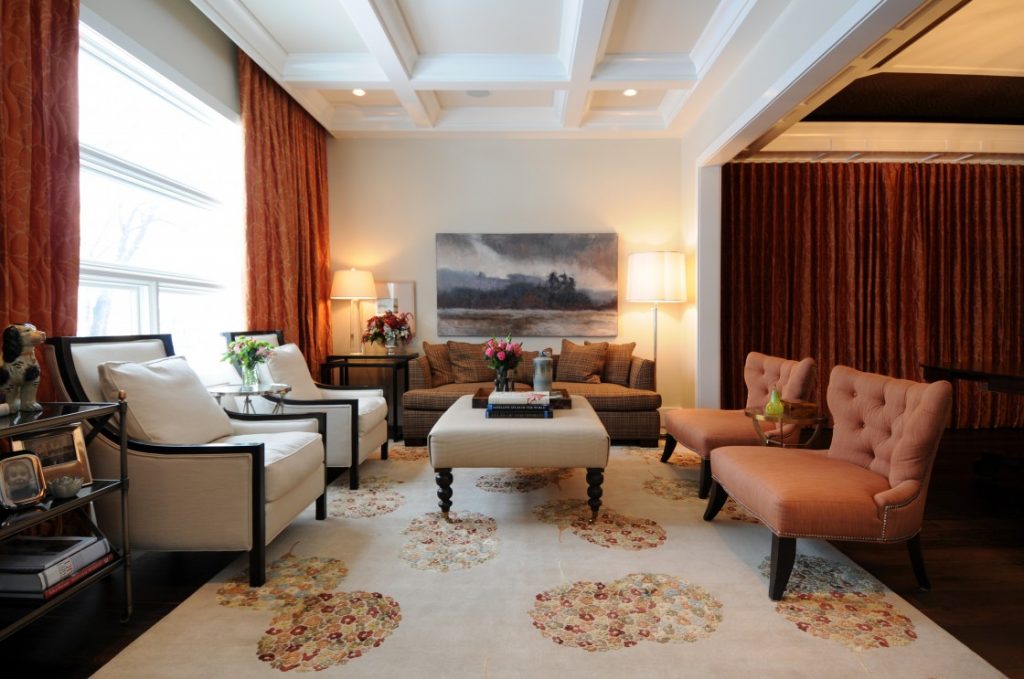
Whatever the final choice of material, do not forget about their advantages and disadvantages.
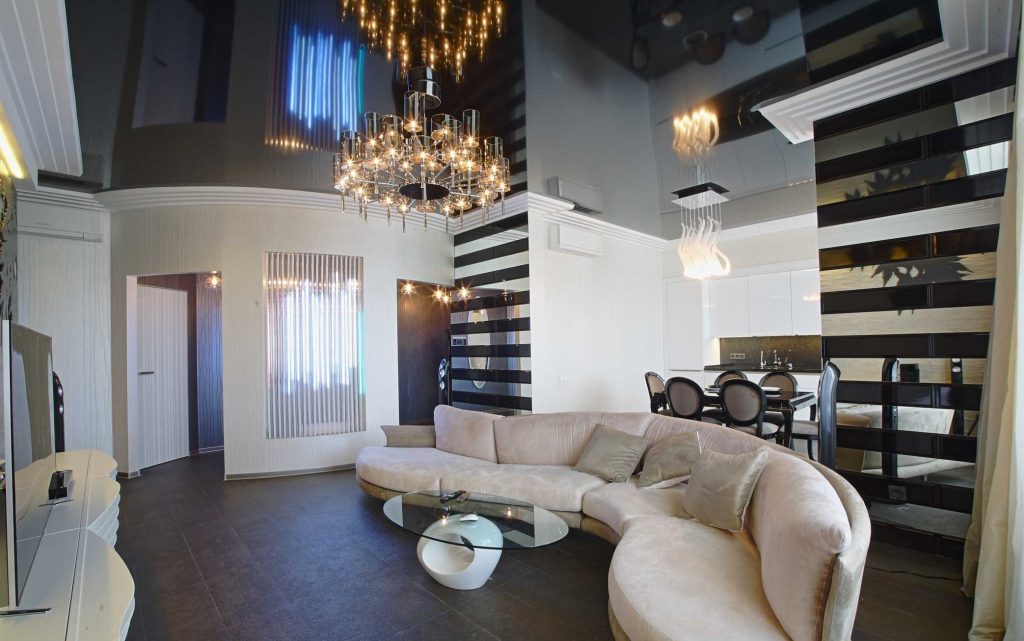
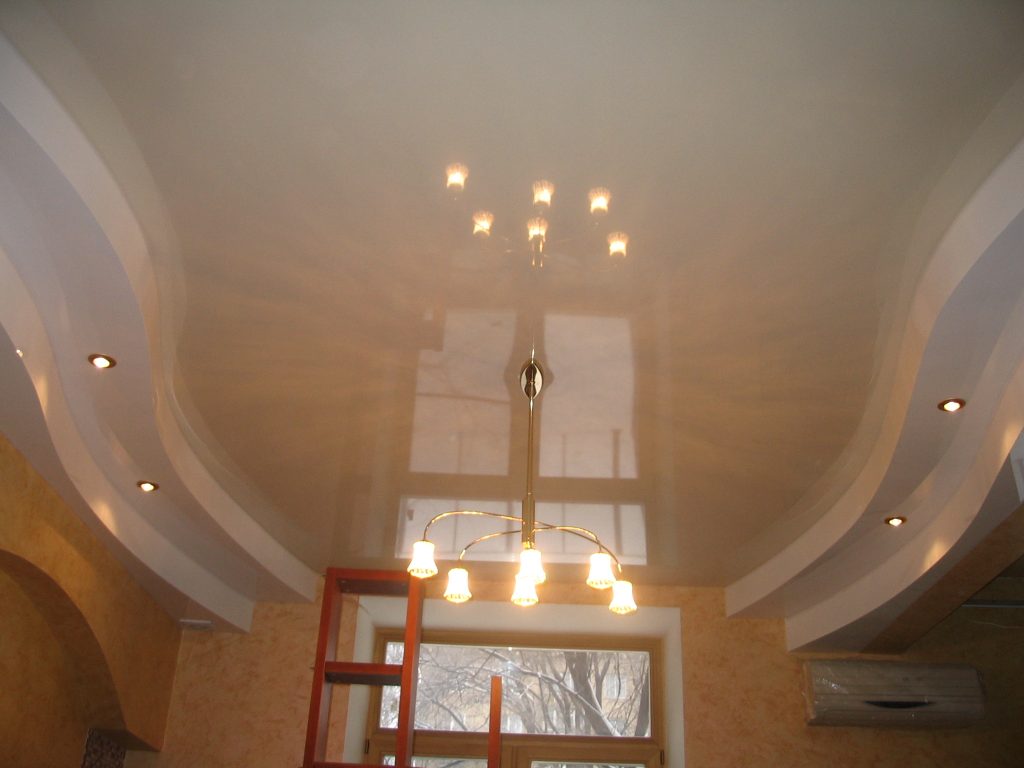
Color solution
This technique should be given special attention, you should approach the choice of the desired shade as competently as possible. It has to do with emotional and psychological influence per person. When creating a living room, it is better to choose calm colors that do not differ in saturation, although the latter largely depends on the amount of sunlight.
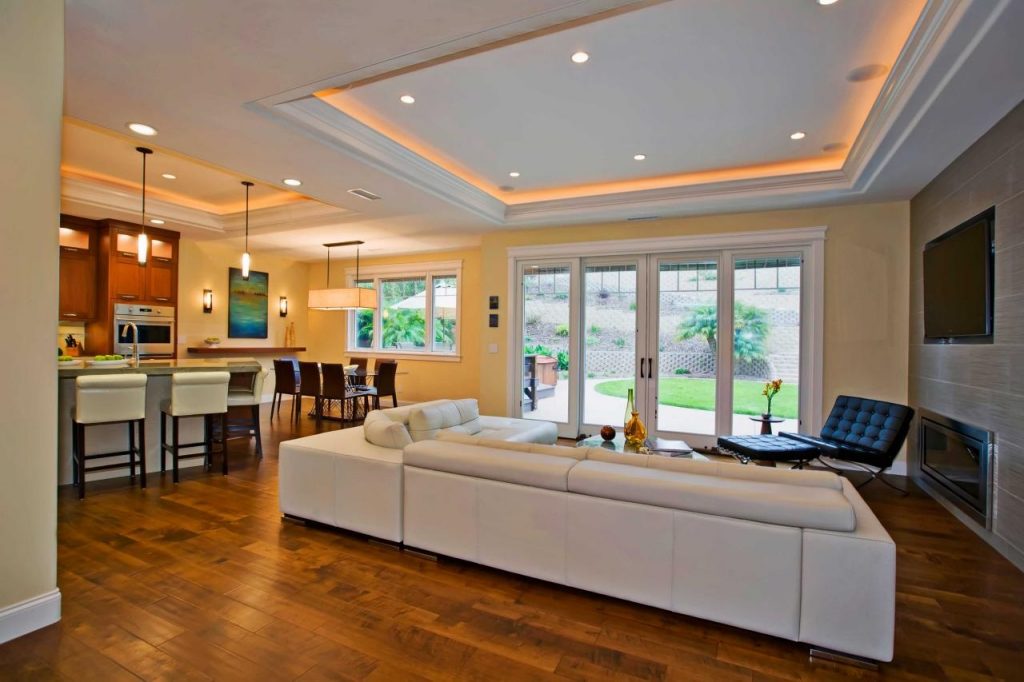
If the option involves connecting the room and the kitchen, then here you can also get rich shades that can not only give the space a certain personality, but also restore appetite.
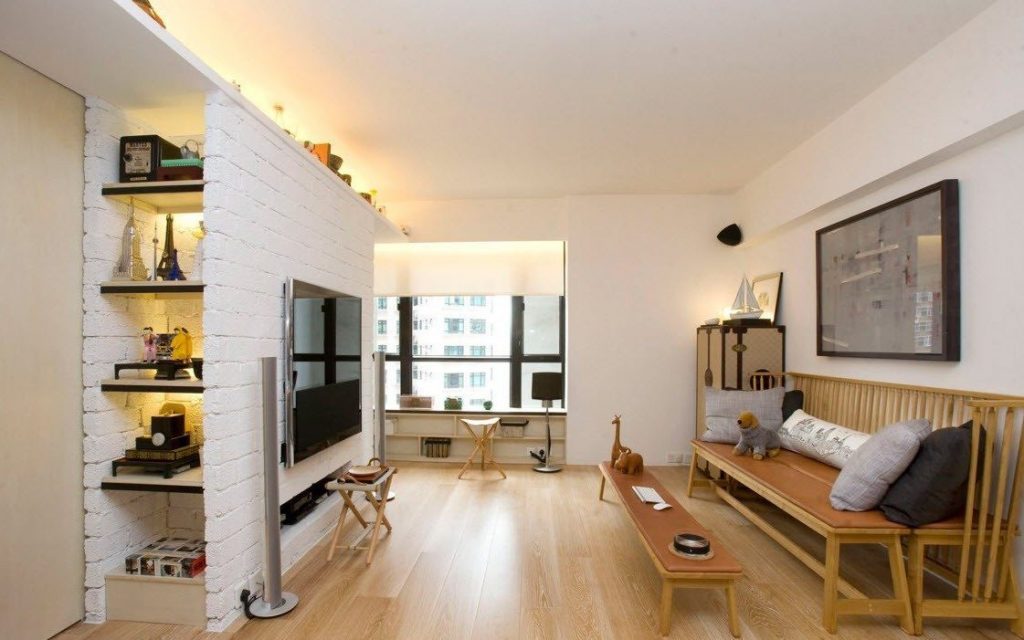
When combining a living room with a bedroom, it is recommended to give preference to more muted varieties of color schemes. They help create a calming effect.
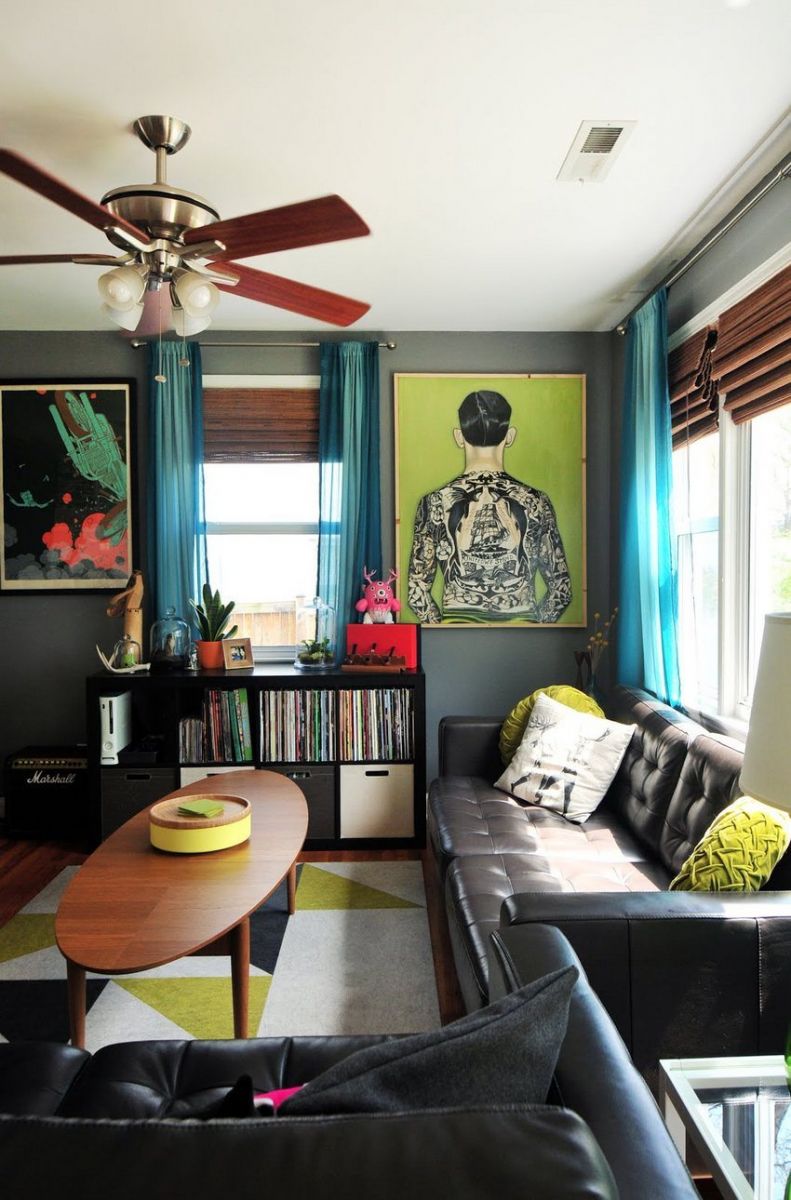
Ceiling decoration options
In addition to the main ways to create an unusual ceiling interior in the living room, there are also additional ways to decorate:
- stucco - great for gothic and classical styles;
- painting - gives the ceiling unusual and individuality;
- stickers - is relatively rare, but in the end it is a rather beautiful option;
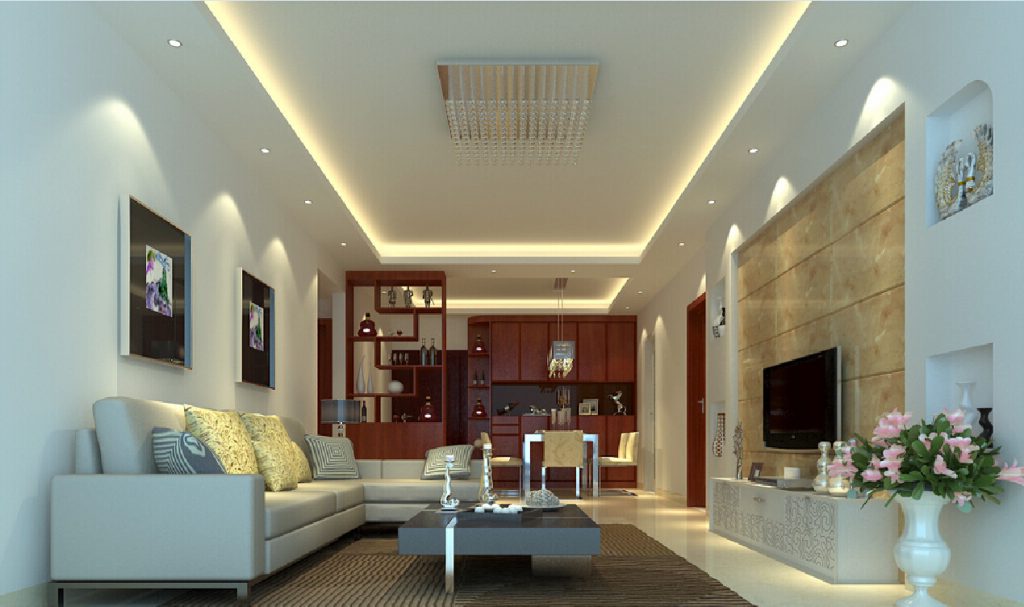
Also, the use of beams can be added to additional methods, since it is this option that makes it possible to create an atmosphere of some antiquity and look good in a modern interior.
![]()

Photo ideas for ceiling design in the living room

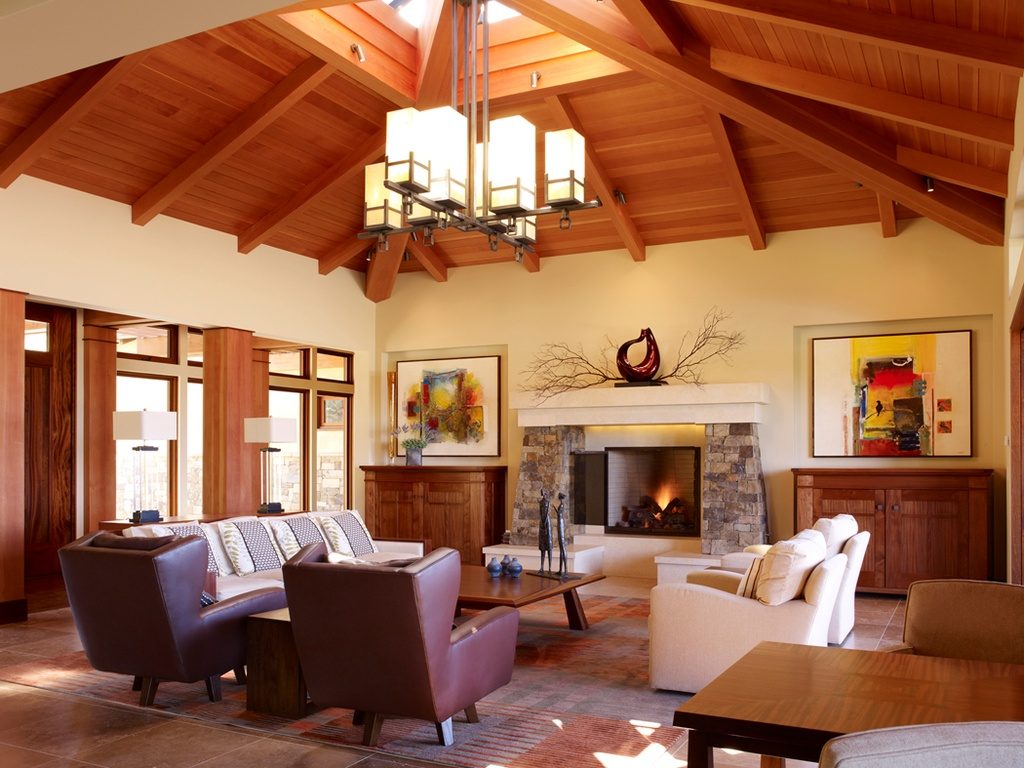
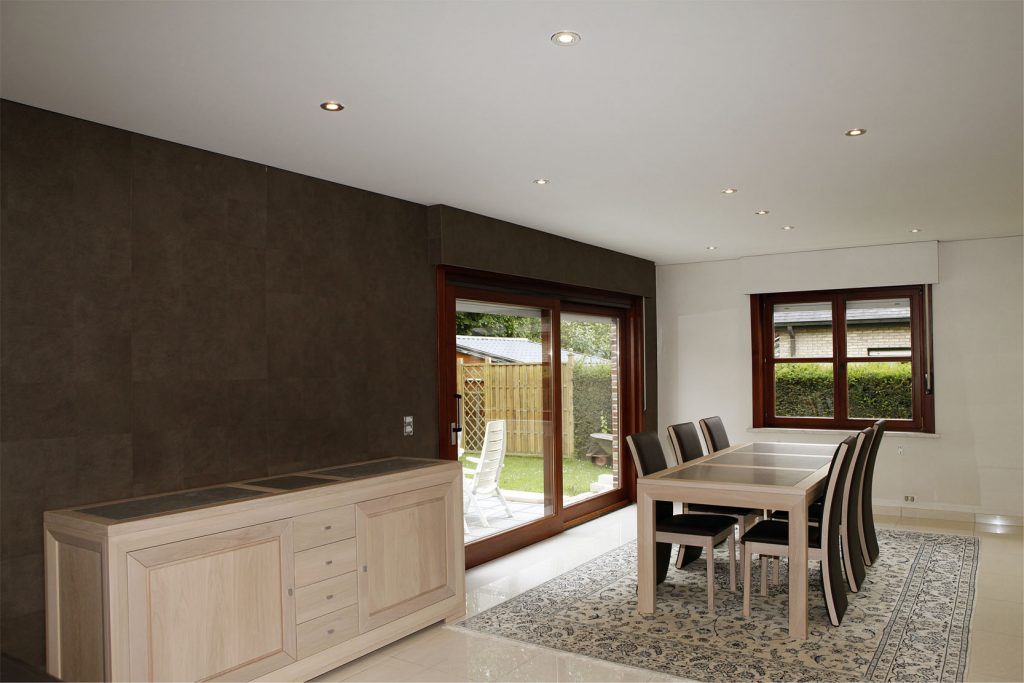
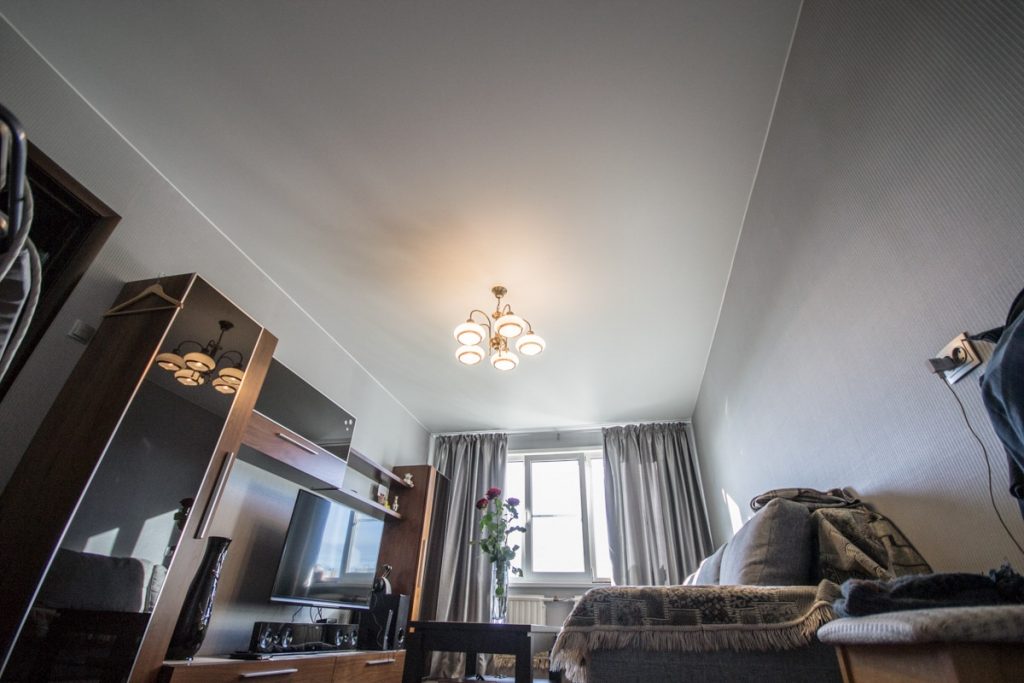
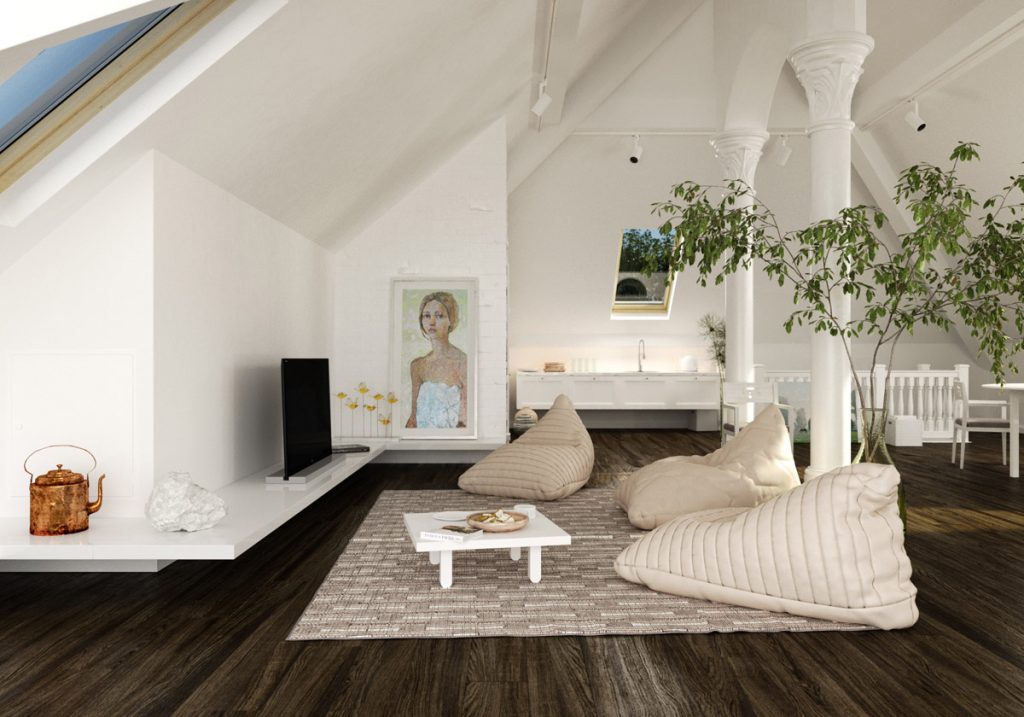
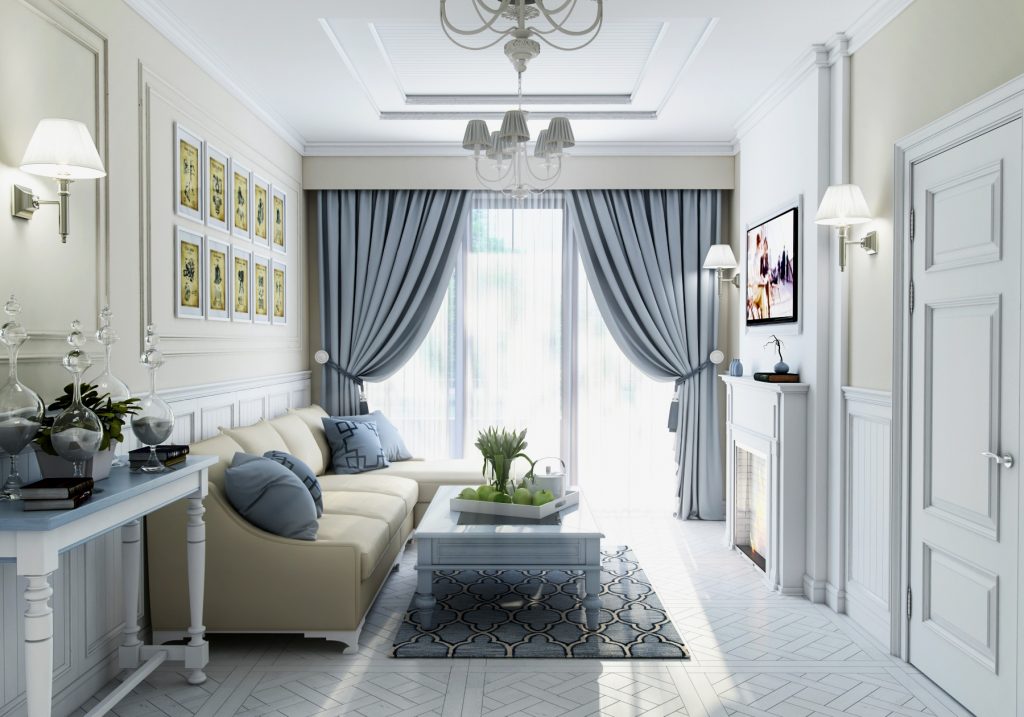
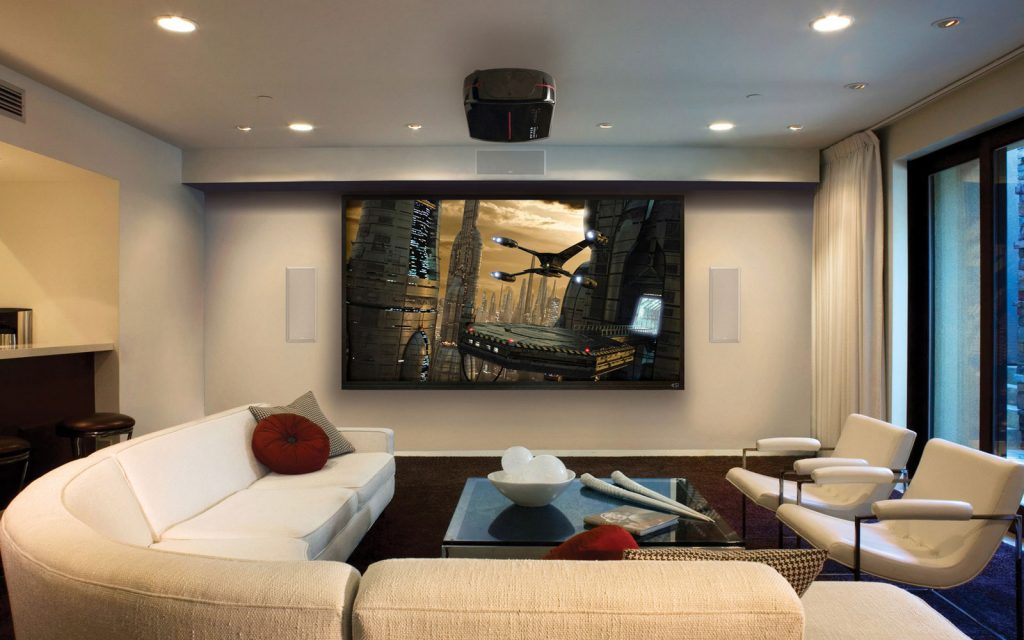
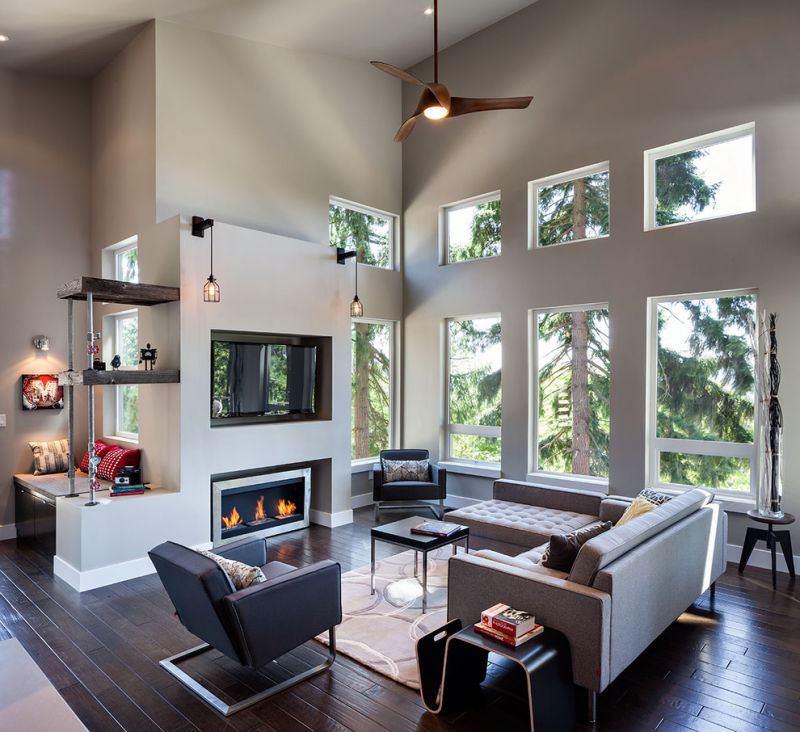
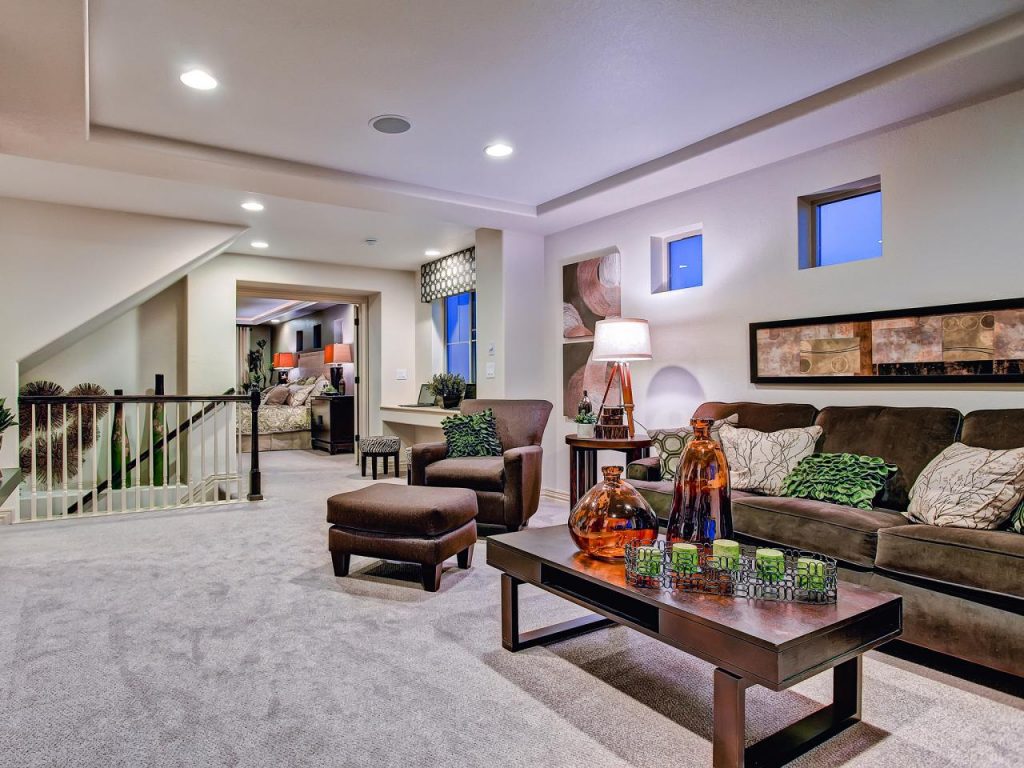

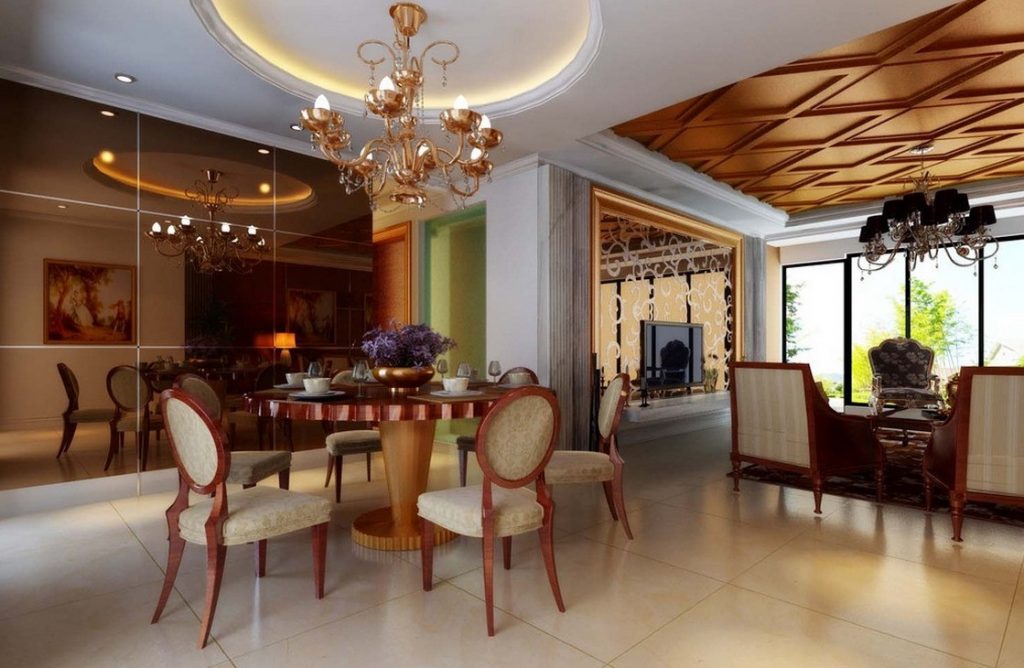
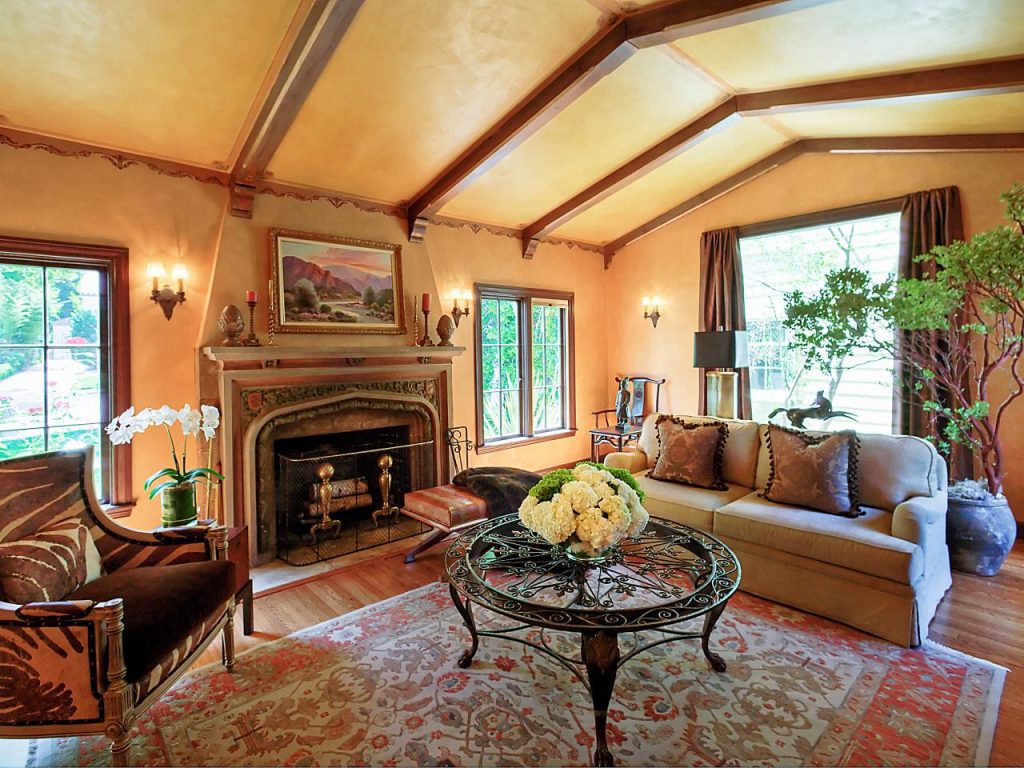
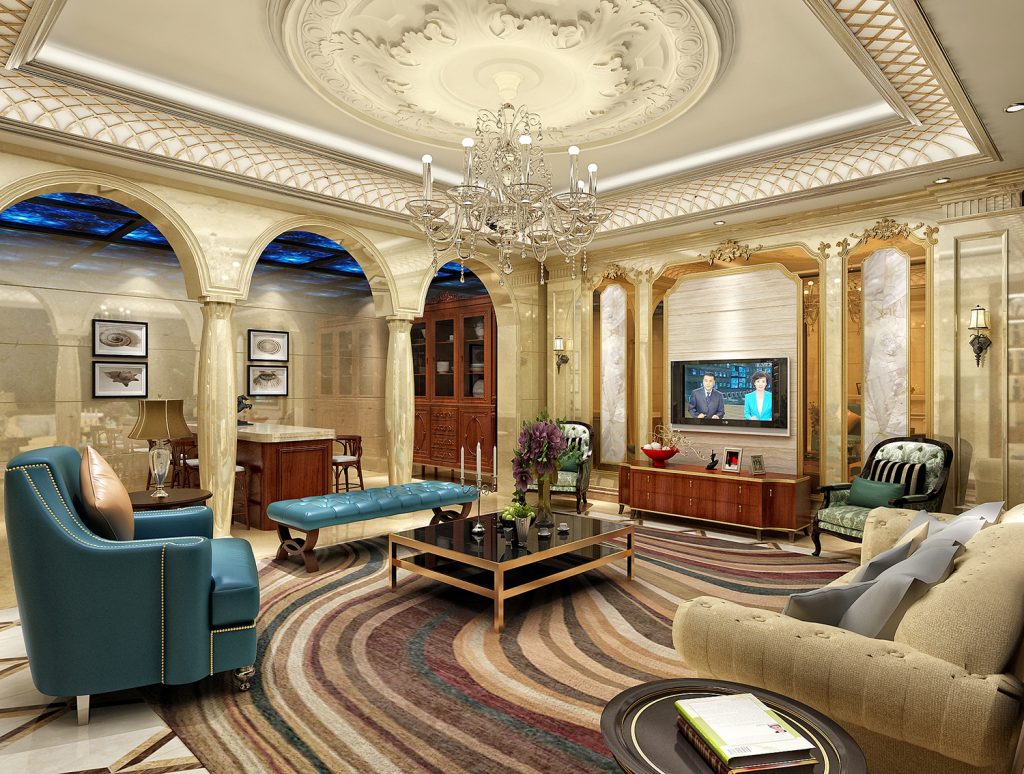
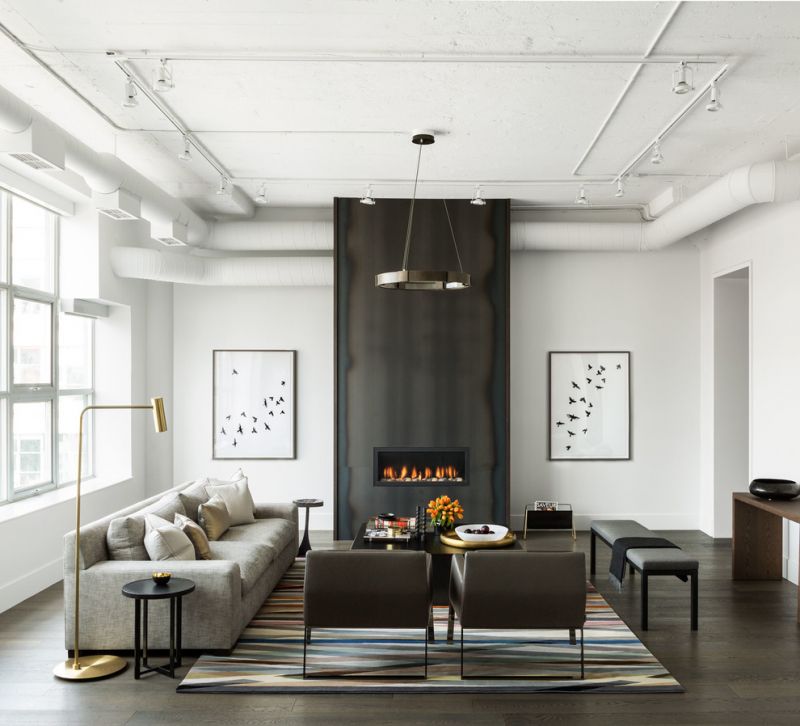
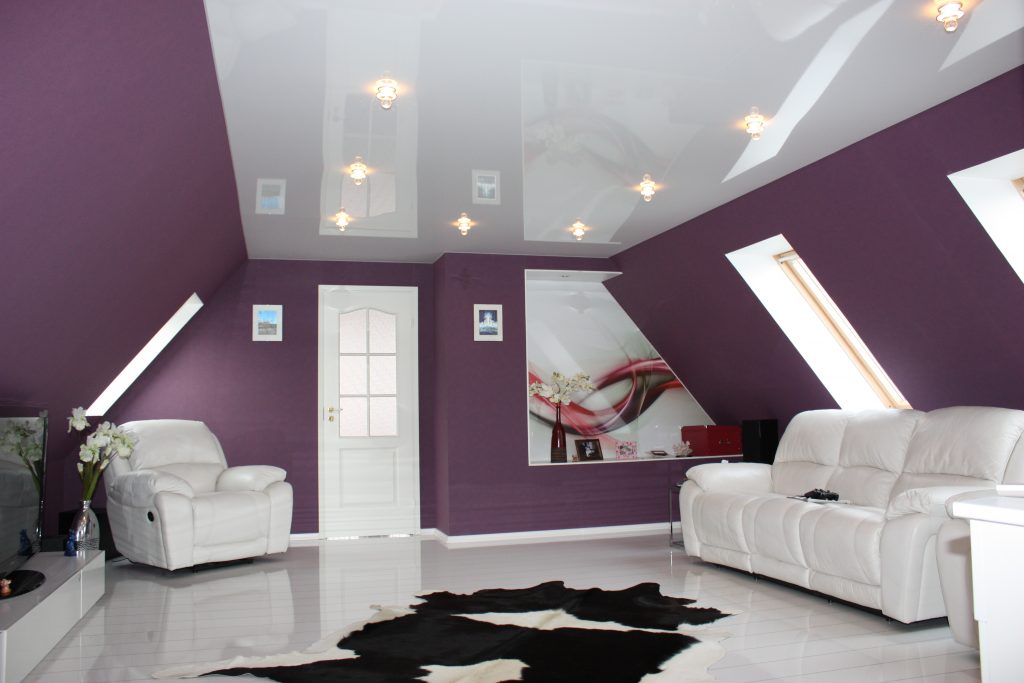
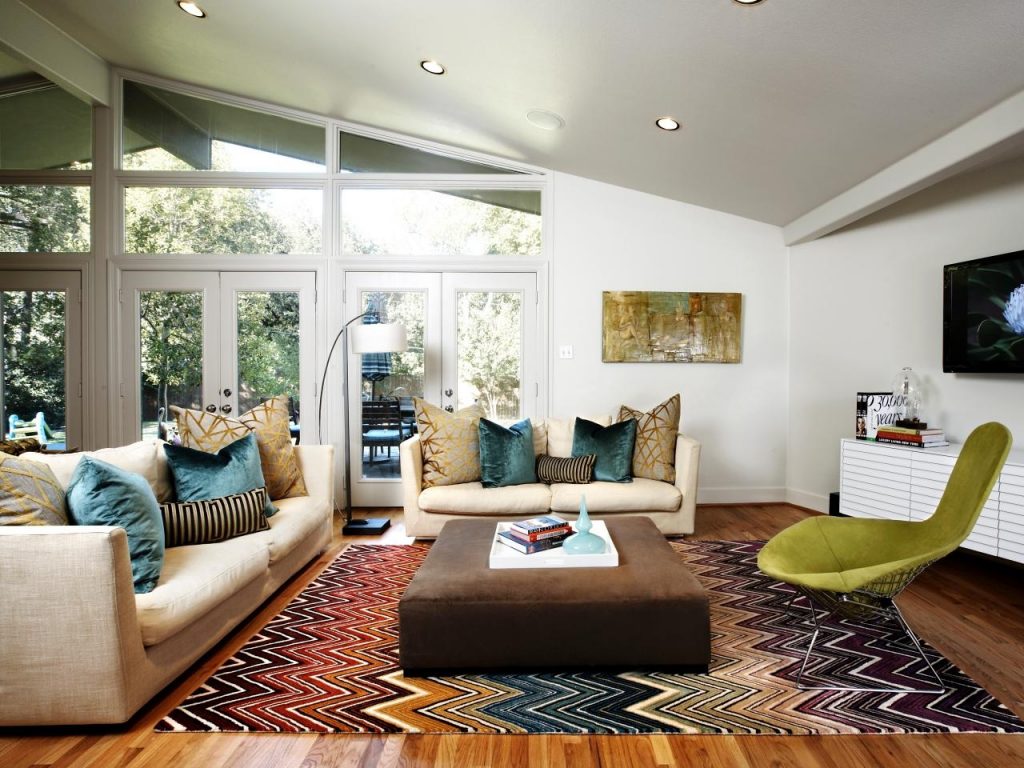
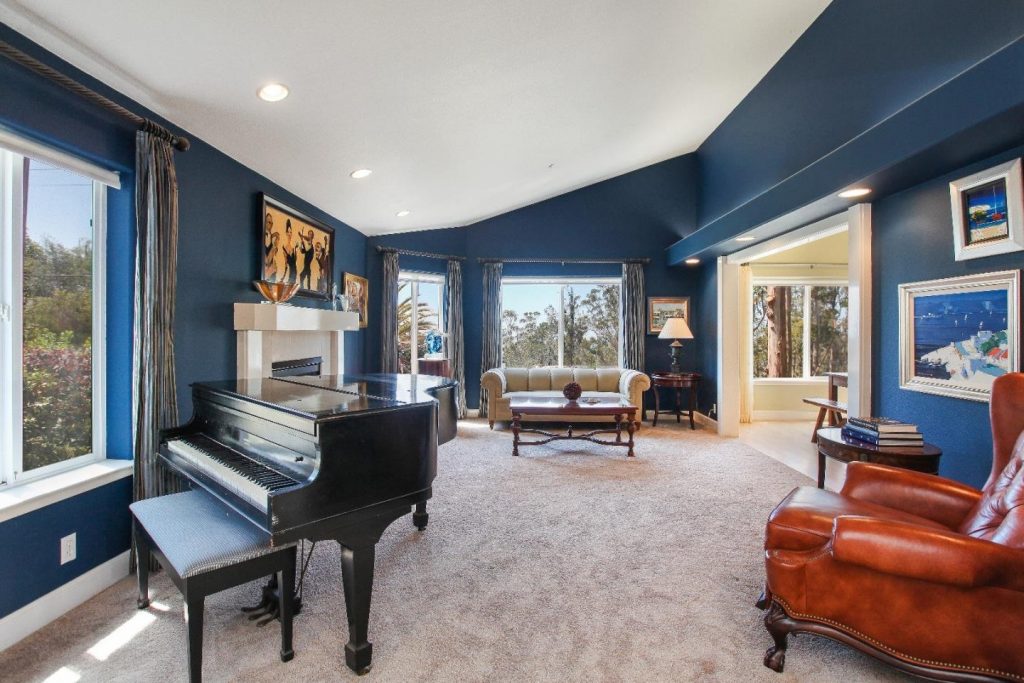
Plasterboard ceilings in the living room are currently a very popular option for finishing the ceiling surface. This is due, first of all, to those interior advantages that such a ceiling gives. First of all, suspended ceiling from drywall can be made multi-level. Which is an excellent solution for some varieties of interior style.
In addition, drywall ceilings are good at hiding irregularities and other imperfections in the underlying horizontal surface. They can be easily embedded spot lighting. And also more serious lamps. However, suspended ceilings made of such material also have quite serious drawbacks. Therefore, we decided to devote our article to the topic: “is it worth making a plasterboard ceiling”?
Is drywall suitable for creating a suspended ceiling finish?
Drywall is a very popular, high-quality and inexpensive material that has long been widely used by builders and decorators. It is used for a wide variety of finishes. Including for the creation of suspended ceiling structures.
Why is drywall used to create suspended ceilings. Is he that good? If, in general, to answer this question, then it can be noted that drywall is a material that represents an ideal value for money. For such a price, this material has very impressive advantages, let's look at them. 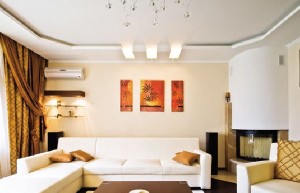
- Drywall is a material that is easy to work with, it cuts well, bends, it can be quite easily given the desired shape and not break.
- This material is completely environmentally friendly. Harmful chemicals are not used in its manufacture, so it can be used in a residential area without fear.
- In combination with specialized soundproofing materials, drywall is able to fully or partially protect you from annoying sounds coming from neighboring apartments.
- With the help of drywall, you can create a perfectly flat surface and mask the imperfections of horizontal and vertical surfaces.
- Drywall has good fire resistance. It does not burn and does not emit harmful substances when heated, and what else is needed to ensure the fire safety of the material.
- There is also an opinion that drywall helps maintain normal air humidity in a house or apartment, since cardboard absorbs excess moisture when the room is too humid and releases moisture when the air is dry.

Structural features of suspended plasterboard ceiling
A suspended plasterboard ceiling is a metal profile fixed below the base ceiling surface, to which drywall sheets are attached. All this forms an integral single-level and multi-level ceiling structure. In the manufacture of the frame, care must be taken to ensure that it is as rigid and reliable as possible. Before you start installing the prepared drywall on the profile, you need to take care of laying electrical communications for future lighting, the task of which is to provide additional lighting in the living room and give its interior a special look.
After the installation of drywall sheets, the most unpleasant and dirty stage of work begins - this is the surface treatment of the material with putty and its coloring. After that, we can say with confidence that your ceiling has changed and has become a worthy element of the future interior of the living room.
The main advantages of plasterboard suspended ceilings
In order to more or less accurately determine whether it is worth installing a plasterboard ceiling in your living room, you need to list its main advantages.
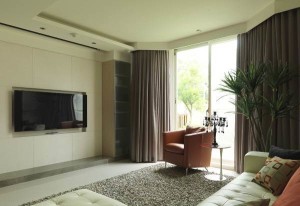
The main disadvantages of plasterboard ceilings
Having talked about the advantages of plasterboard ceilings, one cannot fail to say a few words about their disadvantages.

Summing up, we note that, given the level of development modern technologies in the field interior decoration rooms, a plasterboard false ceiling is far from being the ultimate dream, but it would be premature to write it off. The plasterboard ceiling structure, for all its disadvantages, has much more advantages, so when choosing the option for finishing your ceiling in the living room, at least pay attention to this option, maybe it’s what you will like.
Photo of a plasterboard ceiling in the living room
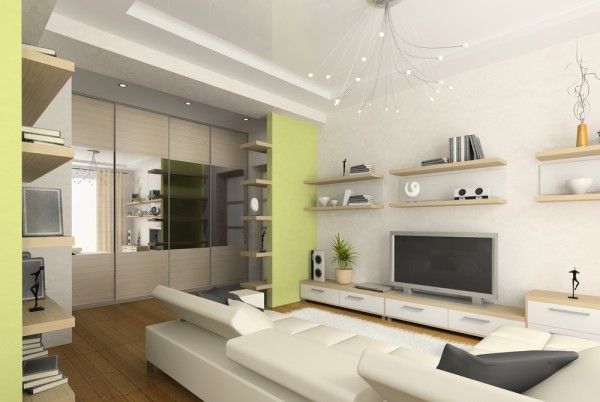
The design of the ceiling in the living room can be a factor in determining the comfort in the entire apartment. You can choose single and multi-level designs, complex shapes or laconic lines, bright colors or watercolor shades - it all depends on the main interior concept.
Keep in mind that multi-level ceilings will look harmonious only if the original ceiling height is above 2.7 m. Otherwise, they will turn out to be too bulky and “crush” the room with their volume. Fortunately, for standard living rooms with a ceiling height of 2.3-2.5 meters, you can use single-level structures with a glossy surface that expands the space.
Step one - focus on style
The ceiling in the living room is not only the surface where the lighting fixtures are located, it is also a logical continuation. You can’t do without taking into account modern interior trends. The main among them are:
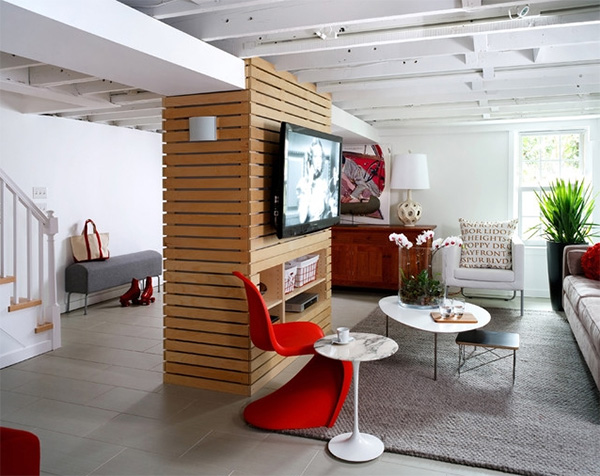
Important. Do not forget that within the same living room you can implement several interior solutions that are close in spirit. Zoning space, dividing it according to its functional purpose is very important for the living room, which combines recreation and work areas, receiving guests and children's games. The ceiling in this case becomes the unifying plane.
Step two - choose the lining material
To select the appropriate material, you need to take into account all the functional tasks that the ceiling solves:
- correct location of light sources;
- disguise of engineering communications;
- leveling existing surfaces;
- decorative matching.
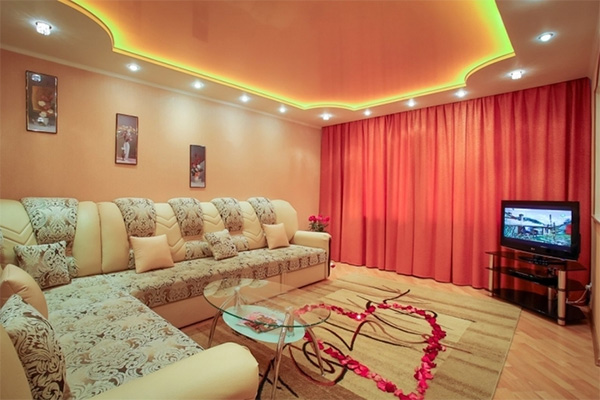
The main lighting is done around the perimeter of the room
All of these criteria will be met. They are easy to install, mask the existing defects in the base, wiring for lighting fixtures, are fireproof, protect against flooding, environmentally friendly, do not absorb odors and dust, and are combined with any interior solution.
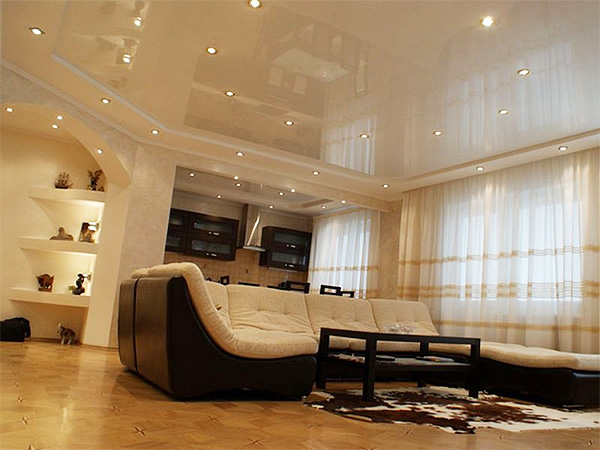
Recessed lights evenly spaced throughout the ceiling
In addition, stretch ceilings are installed with virtually no debris and dust, which is important for living rooms in which repairs have already been completed. Among the advantages of the material is unlimited design variability.

You can give preference to glossy surfaces that increase space, or classic matte textures, choose any color or even a photo print (from a flower meadow to a sunny sky).
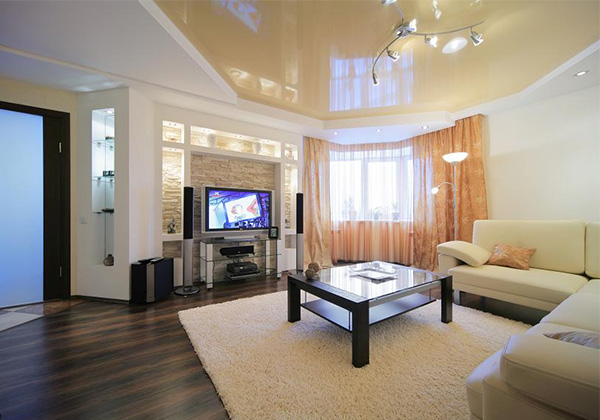
Glossy stretch ceiling in the living room
Making a living room in eco or country style may require the use of wood flooring. Such suspended slatted ceilings environmentally friendly, aesthetically pleasing and perfectly adjust the existing ceiling plane.
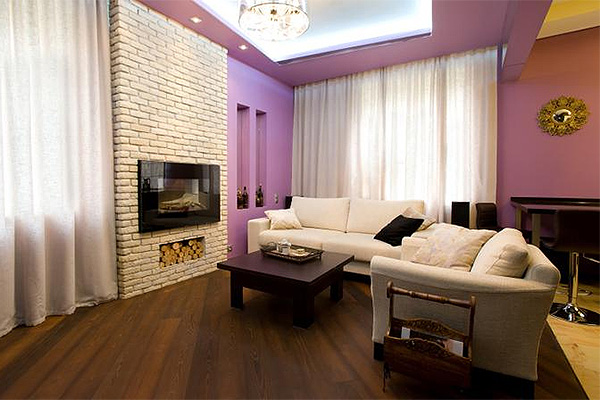
3 light sources: chandelier + recessed lights + LED strip
The tree is not necessarily used "solid" - accent decorative beams will be enough to indicate the style.
Advice. There is a gap between the suspended ceiling material and the base, which can be used for laying communications and for creating a heat and sound insulating layer.
Classic suspended structures include. They can be used as an addition to a stretch ceiling or as an independent material. Plasterboard sheets perfectly hide defects in the base, allow you to lay the necessary communications and install the required lighting fixtures.
Among the main advantages of GKL are environmental friendliness, ease of installation, the ability to create multi-level ceilings of the most complex shapes and any dimensions. Such designs are used when it is necessary to highlight certain areas in the living room or install local spotlights.
Combination of stretch and false ceiling
Keep in mind that the installation of such a ceiling is carried out only after all work on laying communications has been completed. The finished structure must be decorated, for which different methods are used:
- plastering with subsequent staining - in this way uniform textures of deep colors are obtained;
- wallpapering - used less frequently than painting, but allows you to create interesting design solutions when part of the ceiling is designed in the same way as the wall, without transition;
- decorative plaster - allows you to create an expressive relief on the ceiling surface;
- the use of additional decor - stucco moldings, skirting boards, combinations of colors and textures. The latter option is more often used for multi-level zoning structures.
Multi-level plasterboard ceiling + stretch glossy
Each element of a multi-level plasterboard ceiling can be painted in its own shade, corresponding to the functional area. However, you should always remember that light colors increase the space, while dark colors make the room more compact.
To decorate the ceiling in the living room, you can also choose ready-made suspended structures in the form of identical squares or stripes. They are easy to assemble and unpretentious in operation, but too simple for a harmonious living space.
Plasterboard ceiling and turning spots
Regarding the use plasters, then this type of decor is considered budgetary, but rather difficult to implement. Here you can not do without preparatory work to ensure the evenness of the base. In addition, such a ceiling will not help to hide the wiring, and the installation of recessed spotlights is not possible.
Ceiling with LED lighting
If the plaster is applied with a deep texture, then color perception may be distorted due to the appearance of areas with a shadow. Ceiling painting also cannot be called a modern way of decorating - it is inexpensive, but will not be able to produce the desired effect in a perfectly thought-out room.

